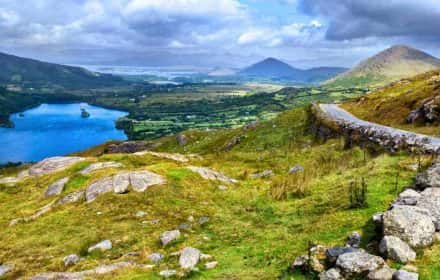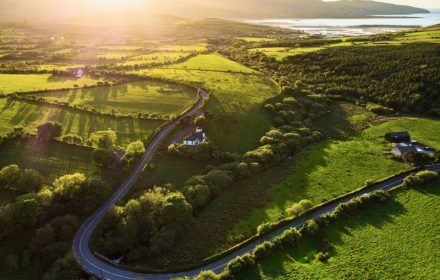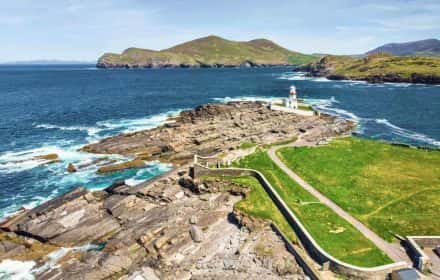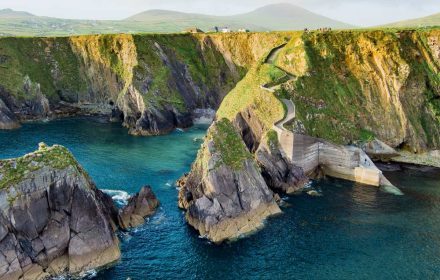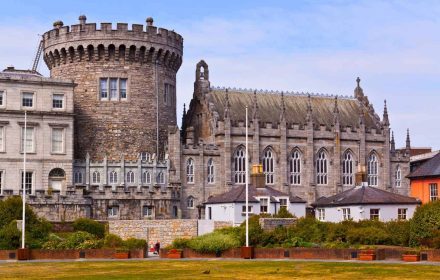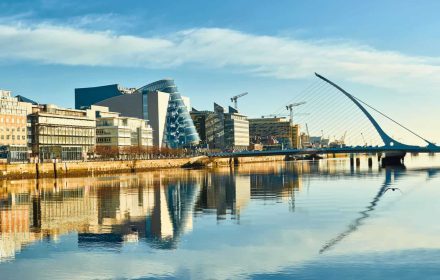This site uses affiliate links, meaning that if you make a purchase through our links, we may earn an affiliate commission.
Ireland is known for its stunning landscapes and rich history, making it a great destination. Here is your go-to resource for planning a 10-day Ireland road trip itinerary! This itinerary is based on my own experiences and is designed to help you navigate the country’s roads and discover the best of its treasures.
With a detailed map and practical tips, you’ll be well-equipped to explore everything from the iconic Cliffs of Moher to the streets of Dublin. This guide will ensure you make the most of your time in Ireland.
- 1. Map of 10-Day Ireland Road Trip itinerary
- 2. DAY 1 - Arrival and Dublin
- 3. DAY 2 - Dublin
- 4. DAY 3 - Dublin to Killarney
- 5. DAY 4 - Killarney National Park and Ring of Kerry
- 6. DAY 5 - Dingle Peninsula
- 7. DAY 6 - Tralee to the Cliffs of Moher
- 8. DAY 7 - Cliffs of Moher
- 9. DAY 8 - Doolin to Portrush
- 10. DAY 9 - Northern Ireland
- 11. DAY 10 - Belfast and Drive Back to Dublin
- 12. Intrepid Scout's Tips for 10-Day Ireland Road Trip Itinerary
Map of 10-Day Ireland Road Trip itinerary
DAY 1 - Arrival and Dublin
- Arrive in Dublin
- Trinity College and the Long Room
- Ha’penny Bridge
- Temple Bar District
- Settle Into Your Accommodations in Dublin
GOOD TO KNOW: Day 1 in Dublin will start with your arrival in the vibrant city. Next, you will dive into Dublin’s rich history and culture with a visit to Trinity College and the awe-inspiring Long Room. Next, you will cross the iconic Ha’penny Bridge and immerse yourself in the Temple Bar District, known for its pubs, live music, and street performers. Finally, you will settle into your accommodations in Dublin.
Trinity College and the Long Room
Start your Dublin exploration with a visit to Trinity College. Established in 1592, Trinity College is the country’s oldest university and boasts a rich history.
The Long Room, part of the college’s Old Library, is a majestic hall lined with shelves of ancient manuscripts and rare books. Among these literary gems is the Book of Kells, a 9th-century manuscript renowned for its intricate illumination and religious significance.

Long Room at Trinty College
Ha'penny Bridge
The Ha’penny Bridge, a beloved Dublin landmark, spans the River Liffey and connects the north and south sides of the city.
Officially known as the Liffey Bridge, it earned its nickname from the toll of half a penny that was once charged for crossing. Designed by engineer John Windsor in 1816, the bridge is an elegant cast iron structure with ornate detailing, making it a picturesque symbol of Dublin.
Today, the Ha’penny Bridge is a popular pedestrian thoroughfare, offering stunning views of the river and the city skyline.
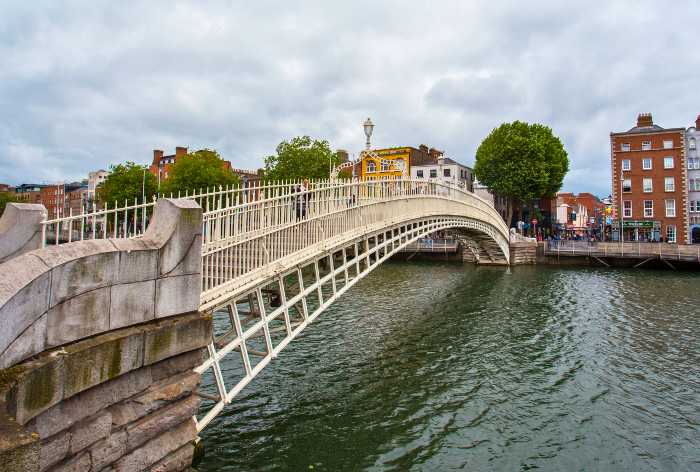
Ha’penney Bridge in Dublin
Temple Bar District
The Temple Bar District is a lively neighborhood that is steeped in history. Named after Sir William Temple, it has evolved into a bustling area filled with pubs, restaurants, galleries, and street performers.
In the heart of the Temple Bar District, you’ll find an array of pubs, each offering its unique atmosphere.
Start your pub-hopping adventure at The Temple Bar, an iconic spot known for its lively ambiance, live music sessions, and extensive drink selection. For a cozy retreat, head to The Auld Dubliner. If you’re seeking history along with your pint, visit The Norseman, housed in a building dating back to 1696 or The Brazen Head established in 1198, it claims to be Ireland’s oldest pub.
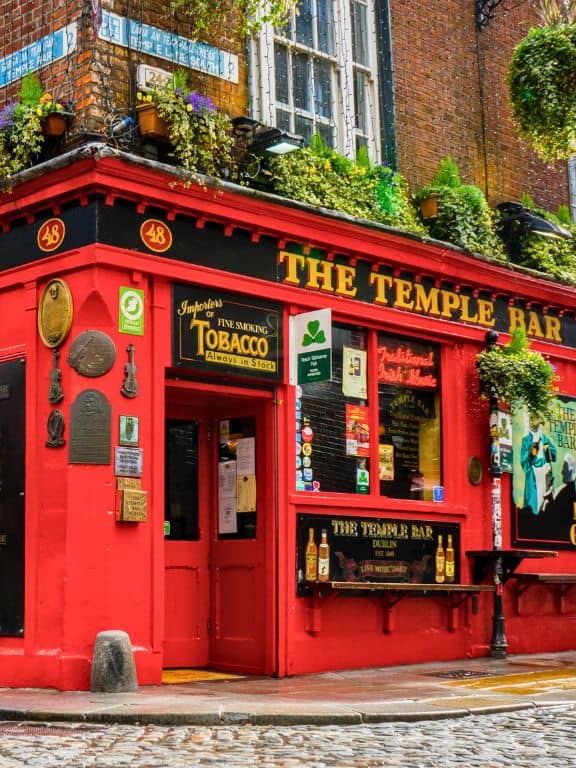
The Famous Temple Bar in Dublin
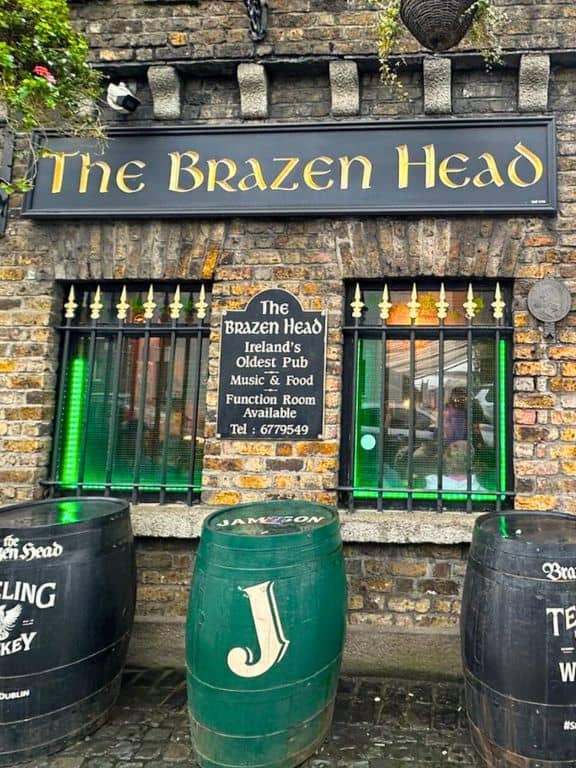
The Oldest Brazen Head Pub in Dublin
Settle Into Your Accommodations in Dublin
Booking accommodations in Dublin at least 3 months in advance is a really good idea. My recommendation is to book your accommodations the minute you know the dates of your travel. Dublin is a busy place and the best accommodations are in high demand, particularly during peak tourist seasons.
If you’re willing to splurge, The Merrion Hotel stands out as my top choice. Its superb location, spotless rooms, and exceptional turn-down service make it an excellent option for a luxurious stay. I always look forward to staying at the Merrion.
Following closely, yet at a much lower price is The Mont. It has a great location that will place you within proximity to the city center while still offering a serene and peaceful atmosphere.
Another place that I stayed at is Hyatt Centric The Liberties. It offers modern amenities. The rooms are clean and comfortable.
My recommendation is to check them all out and see what fits your budget. You will be staying in Dublin for 2 nights.
DAY 2 - Dublin
- Dublin Castle
- Christ Church Cathedral
- Kilmainham Goal
- Guinness Storehouse
GOOD TO KNOW: On Day 2 you will begin at Dublin Castle, then visit Christ Church Cathedral. Next, you will discover the poignant past of Kilmainham Gaol before ending your day at the iconic Guinness Storehouse.
Dublin Castle
Begin your second day in Dublin with a tour of Dublin Castle.
Constructed in the 13th century on a former Viking settlement, it served as a military fortress before adapting to various roles, including as a prison, treasury, and court of law.
From 1204 to 1922, it was the seat of English and later British rule in Ireland. In 1922, it was handed over to the Irish government and repurposed as a government complex.
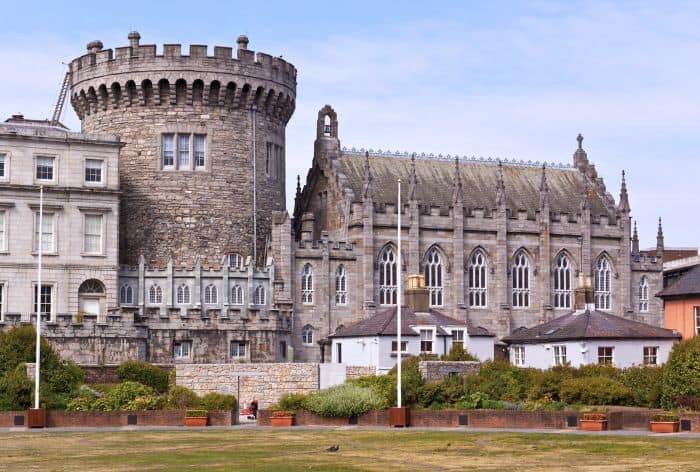
Dublin Castle
Christ Church Cathedral
Next, visit Christ Church Cathedral.
Founded in the 11th century, it is one of the city’s oldest buildings. With its impressive Gothic architecture, the cathedral has been a place of worship for over a millennium.
Inside, you can admire its stunning stained glass windows, ancient crypts, and intricate carvings. Make sure to take a 1-hour self-guided tour of the cathedral.
INTREPID’S TIP: Don’t miss the chance to climb to the top of the tower for panoramic views of the city.
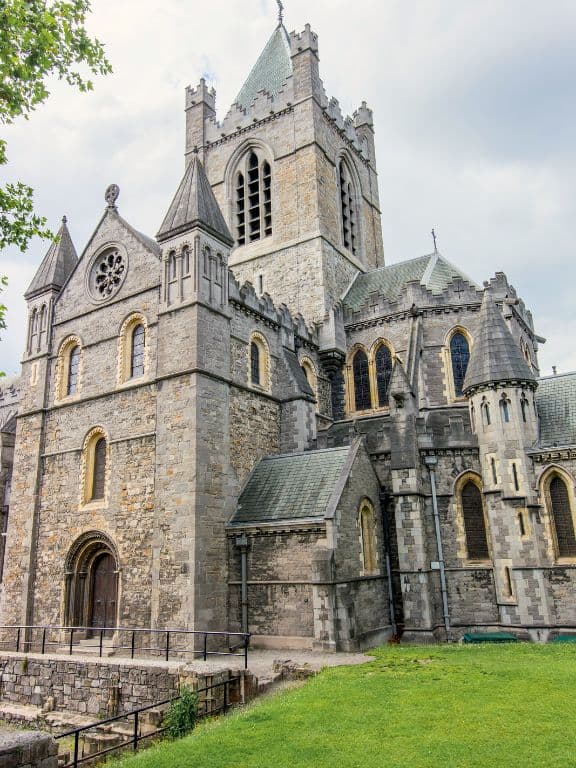
Christ Church Cathedral
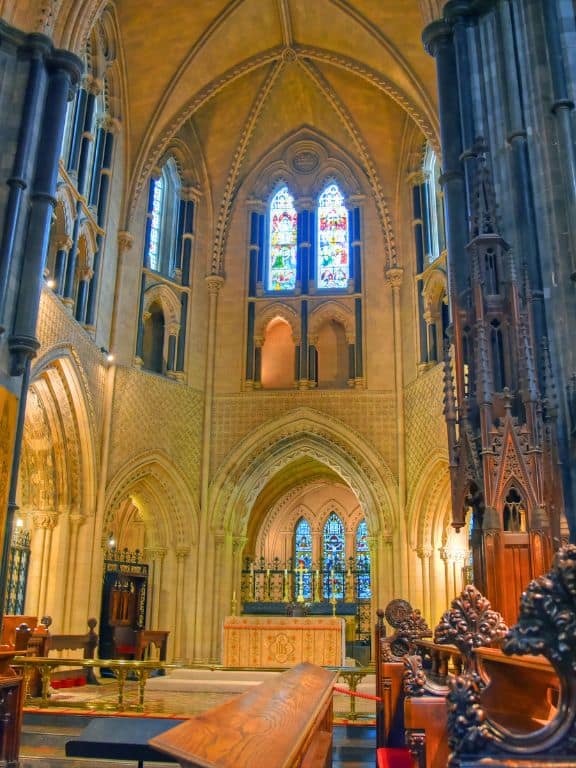
Christ Church Cathedral
Kilmainham Goal
Continue your Dublin exploration with a visit to Kilmainham Gaol.
This historic prison, dating back to the 18th century, played a significant role in Ireland’s struggle for independence. It housed many notable political prisoners, and its stark conditions provide a sobering insight into Ireland’s turbulent past.
Make sure to take a guided tour to learn about the prison’s history and the stories of its inmates, including those involved in the Easter Rising of 1916.
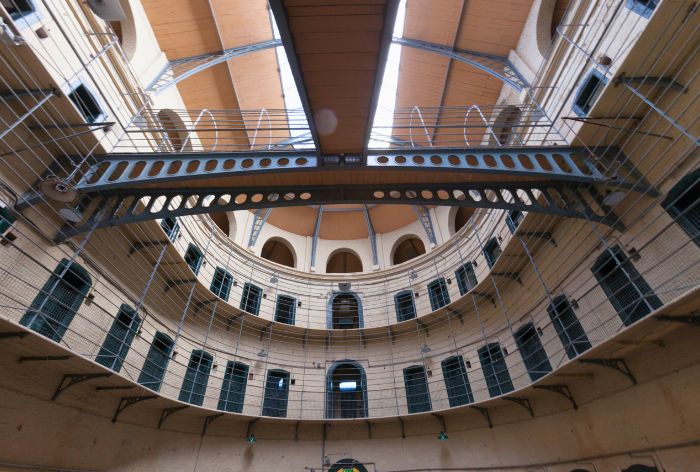
Kilmainham Goal
The Guinness Storehouse
The Guinness Storehouse is the final stop on our itinerary. It is a testament to the rich heritage and brewing tradition of Guinness, Ireland’s most famous beer.
The storehouse spans seven floors and offers tours of Guinness’s history, ingredients, and brewing process.
Additionally, you can enjoy a variety of experiences, including the Guinness Connoisseur Experience, where they can learn about the art of tasting Guinness like a pro, and the Gravity Bar, which offers stunning panoramic views of Dublin while enjoying a complimentary pint of Guinness.
Time to head back to your hotel for the second night in Dublin.
DAY 3 - Dublin to Killarney
- Glendalough
- Kilkenny
- Rock of Cashel
- Hore Abbey
- Cobh
- Blarney Castle
- Drive to Killarney and Settle Into Your Accommodations
GOOD TO KNOW: Day 3 of your itinerary is packed with historical and scenic delights. Begin your day exploring the ancient monastic settlement of Glendalough, followed by a visit to Kilkenny. Continue your journey to the Rock of Cashel and nearby Hore Abbey. Next, make your way to the coastal town of Cobh. Before the day ends, stop at Blarney Castle to kiss the famous Blarney Stone and receive the gift of eloquence. Finally, head to Killarney to spend the night.
Glendalough
The first stop on today’s itinerary is Glendalough, located in the Wicklow Mountains.
It is an ancient monastic settlement founded by St. Kevin in the 6th century. It’s renowned for its well-preserved ruins, including churches, round towers, and Celtic crosses, which offer insights into Ireland’s early Christian history.
The site is surrounded by scenic glacial lakes, towering cliffs, and dense forests.
You can easily spend a day in Glendalough, however, we have not more than 1-2 hours at this location, so here is a condensed version where you can still experience the essence of Glendalough even with limited time available:
- Start by exploring the main highlights of the monastic settlement, including St. Kevin’s Church and the round tower. These central features offer a glimpse into the site’s rich history and architectural significance.
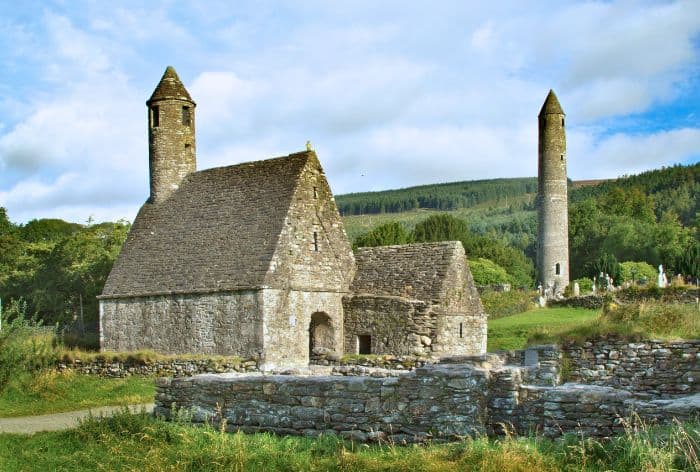
St. Kevin’s Church And the Round Tower in Glendalough
- Take a brief stroll to one of the nearby glacial lakes, such as the Upper or Lower Lake for a chance to soak in the natural beauty of the area.
- Take a moment to enjoy the stunning views of the valley and surrounding mountains from one of the designated viewpoints or walking trails.
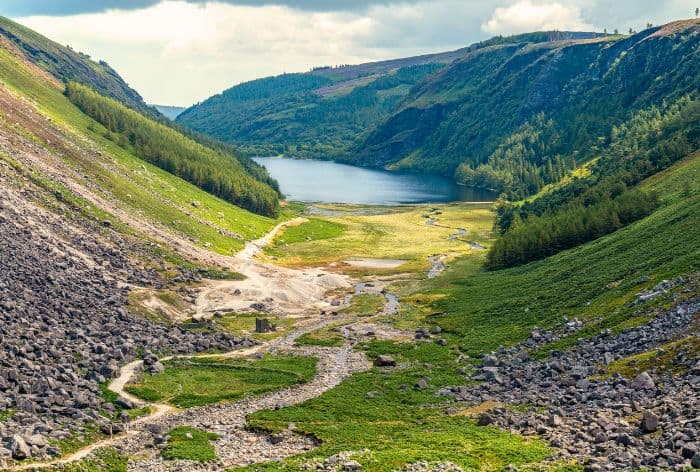
Glendalough Upper Lake
Kilkenny
The next stop is Kilkenny, a medieval town. Kilkenny is often referred to as the “Marble City”.
GOOD TO KNOW: Kilkenny, Ireland has been known as the Marble City for centuries because of its history of exporting black marble to Britain. The marble, also known as Kilkenny Marble or Kilkenny Black Marble, is a fine-grained, dark-colored carboniferous limestone. The city’s streets are paved with Kilkenny marble flagstones, which are highly polished and glisten when wet.
Here are some key highlights to explore during your visit:
- Start your tour with a visit to Kilkenny Castle, a fortress dating back to the 12th century. Explore the castle’s impressive interior, including its grand halls, art galleries, and beautifully landscaped gardens.
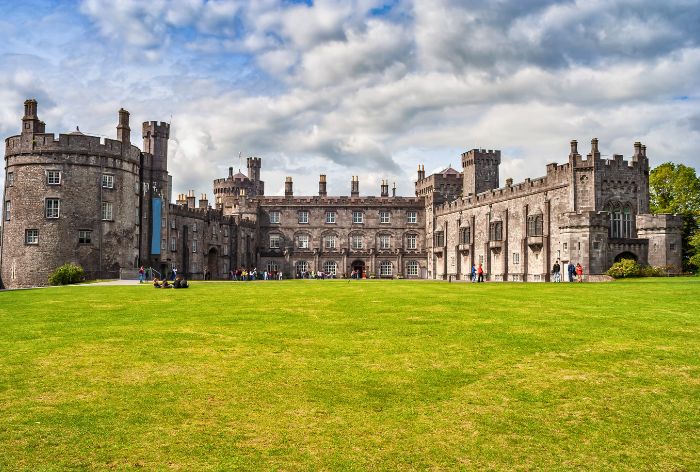
Kilkenny Castle
- Next, head over to St. Canice’s Cathedral renowned for its medieval architecture and iconic round tower.
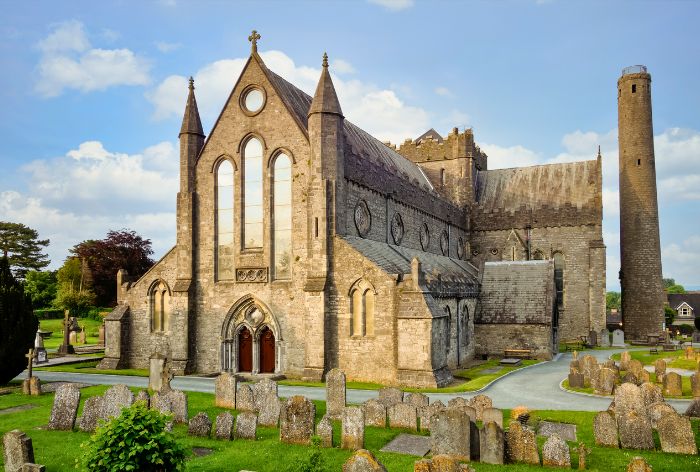
Kilkenny St. Canice’s Cathedral
- Finally, take a stroll along Kilkenny’s Medieval Mile Trail, which begins at St. Mary’s cruciform church and graveyard, established in the 13th century. Along the way, you will learn about Kilkenny’s history as Ireland’s medieval city.
You might want to check out Kilkenny: Historical Highlights Walking Tour. I thought it was great! It is about 2 hours long and takes you through the medieval streets of Kilkenny.
Rock of Cashel
The next stop is the Rock of Cashel, situated on a limestone hill, it features ancient ruins such as a medieval castle, cathedral, and round tower.
It was originally home to the Eóganachta, Kings of Munster. In 1101, it was donated to the Church by King Muirchertach Ua Briain.
St. Patrick visited in 450, baptizing King Aenghus and establishing Cashel as a bishopric.
The round tower dates back to this time. Cormac’s Chapel, built in the 1100s for King Cormac, still stands. A cathedral, erected later, was destroyed in fires in 1495 and 1647.
Book your tour tickets here.
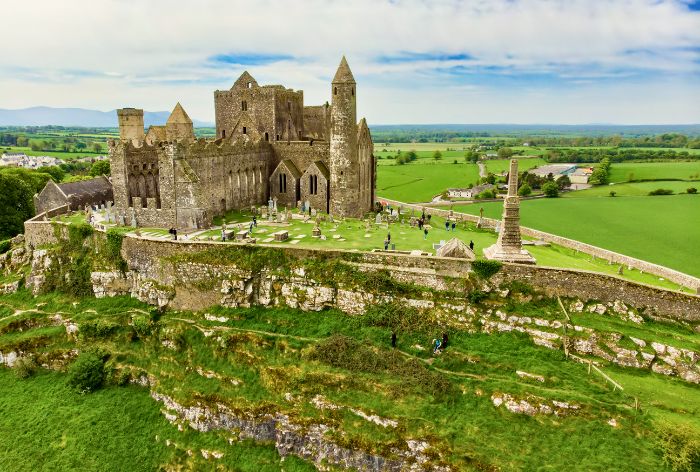
Aerial View of the Rock of Cashel
Hore Abbey
Next to the Rock of Cashel stands Hore Abbey, a historic ruin dating back to the early 13th century. Founded by Benedictine monks, it served as a place of worship for centuries.
Despite facing attacks and periods of abandonment, it remains a fascinating site to explore. You can wander among its crumbling walls and striking tower, imagining the monks who once inhabited this spot.
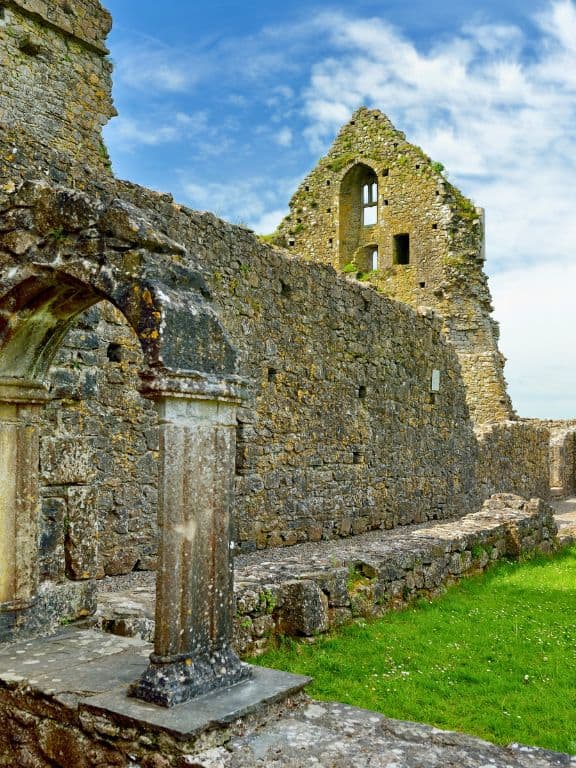
Hore Abbey
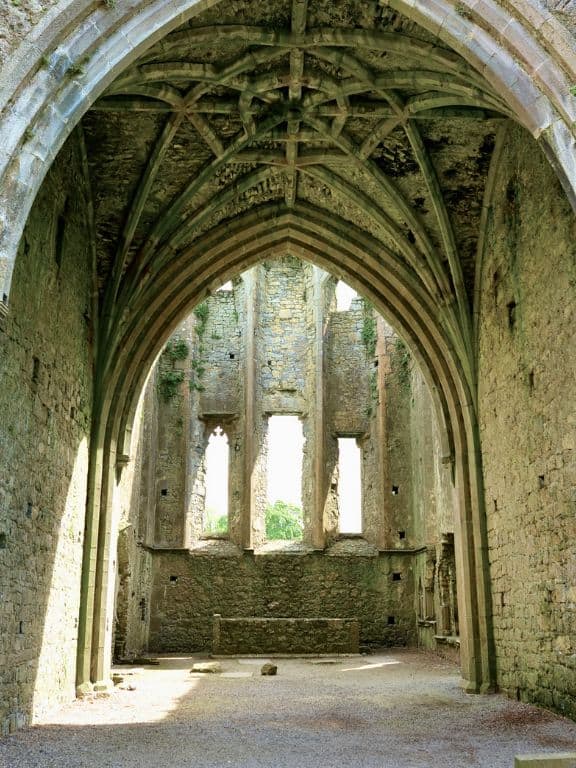
Hore Abbey
Cobh
Next, you’ll visit Cobh, a coastal town with a strong maritime history. As the last port of call for the RMS Titanic in 1912, Cobh is home to the Titanic Experience Cobh, located in the original White Star Line ticket office.
The town features colorful streets, historic architecture, and scenic waterfront views. Visitors can explore attractions like St. Colman’s Cathedral
There are plenty of local cafes so make sure to grab some lunch and a coffee before you head out.
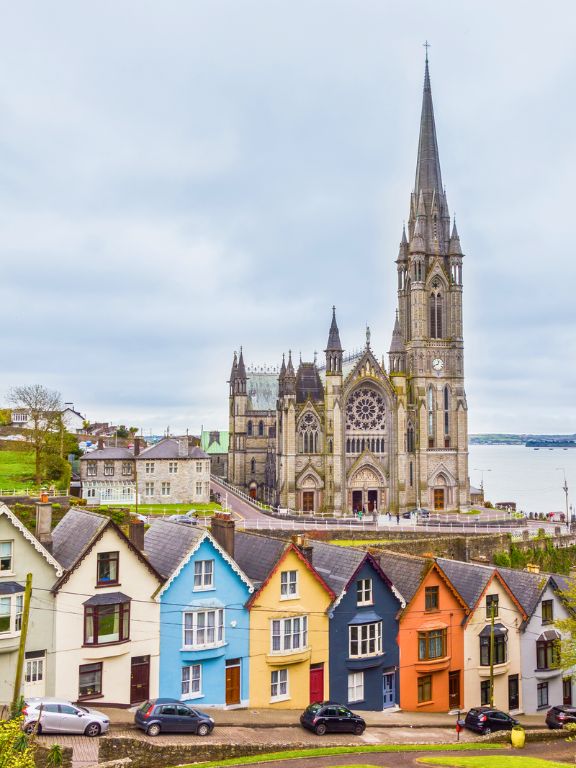
St. Colman’s Cathedral in Cobh
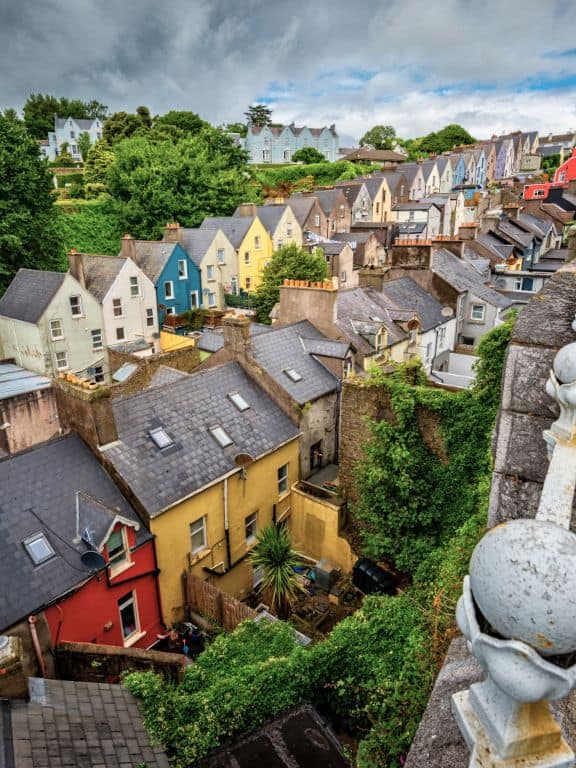
Colorful Houses in Cobh
Blarney Castle
Continuing your journey, you’ll arrive at Blarney Castle, an iconic medieval fortress located near Cork.
Dating back to the 15th century, Blarney Castle is renowned for its legendary Blarney Stone, said to grant the gift of eloquence to those who kiss it.
You can climb to the top of the castle’s battlements to kiss the stone and enjoy panoramic views of the surrounding countryside.
Additionally, the castle’s beautiful gardens, including the Poison Garden and Rock Close, offer spots for exploration.
Check out this tour: Easy Access – The Blarney Stone & Castle Gardens Tour. It lets skip the long ticket lines with convenient access tickets to Blarney Castle and Gardens. Afterward, you can take a guided walking tour of the charming Blarney Village.
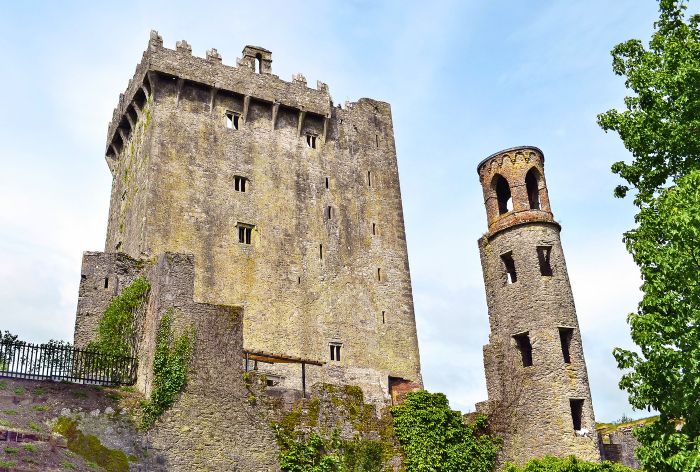
Blarney Castle
Drive to Killarney and Settle Into Your Accommodations
Ahead of you is a drive to Killarney. You will stay in Killarney for 2 nights.
My top choice for a stay in Killarney is undoubtedly The Killarney Park Hotel. Its blend of old-world charm and modern amenities will provide you with an unforgettable experience. I always select a room overlooking the garden and make sure I have at least one meal at their restaurant.
My second choice, Aghadoe Heights Hotel & Spa, is a perfect retreat in Killarney. You will like its modern feel, spacious rooms, and generously sized bathrooms.
DAY 4 - Killarney National Park and Ring of Kerry
- Ross Castle
- Muckross Abbey
- Torc Waterfall
- Ladies View
- Kenmare Stone Circle
- The Kerry Cliffs
- Valentia Island
GOOD TO KNOW: Day 4 takes you through Killarney National Park and the Ring of Kerry. You will start at Ross Castle, then visit Muckross Abbey and Torc Waterfall. Next, enjoy the panoramic views at Ladies View before seeing the Kenmare Stone Circle. End your day at the Kerry Cliffs and Valentia Island.
Ross Castle
Begin your exploration of Day 4 at Ross Castle, a historic fortress located on the shores of Lough Leane in Killarney National Park.
Built in the 15th century by the O’Donoghue clan, it served as a stronghold during Ireland’s turbulent past.
You can take a guided tour of the castle interior, which features furnished rooms and exhibits detailing its storied past.
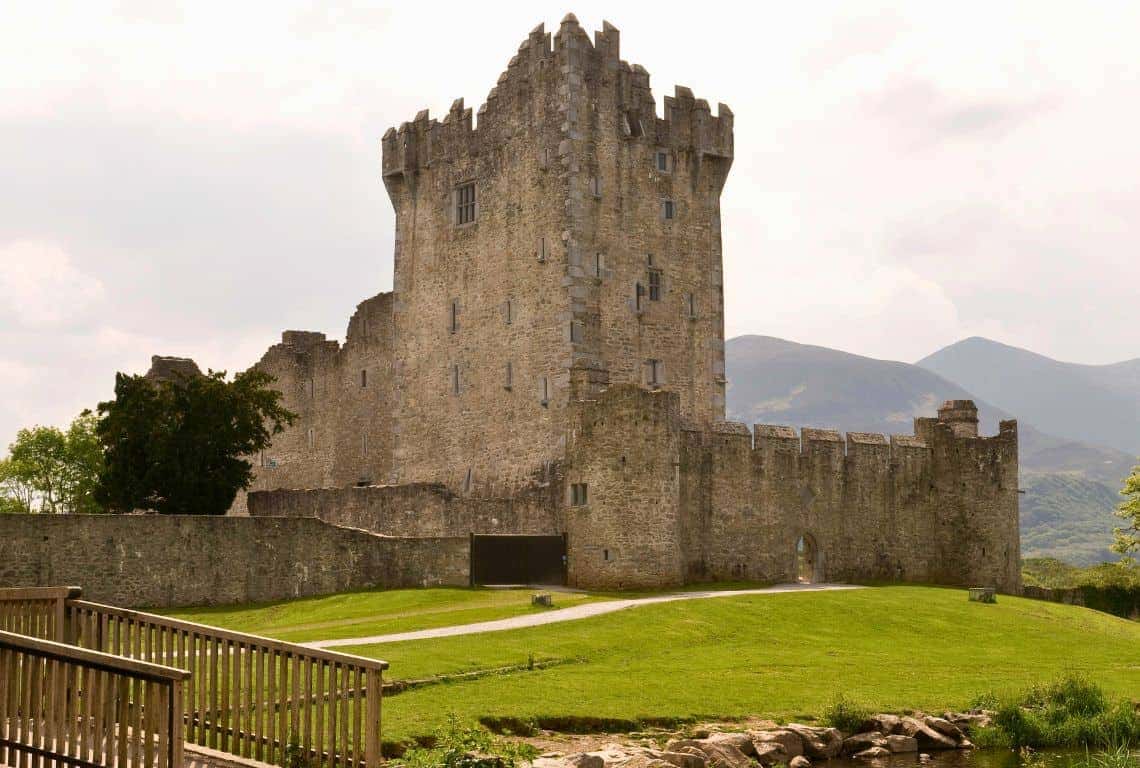
Ross Castle in Killarney National Park
Muckross Abbey
Next on your itinerary is Muckross Abbey located within Killarney National Park.
Muckross Abbey, founded in the 15th century, is a medieval ruin with a well-preserved cloister and intricate stonework.
The abbey has served various purposes over the centuries, including as a place of worship, burial site, and refuge.
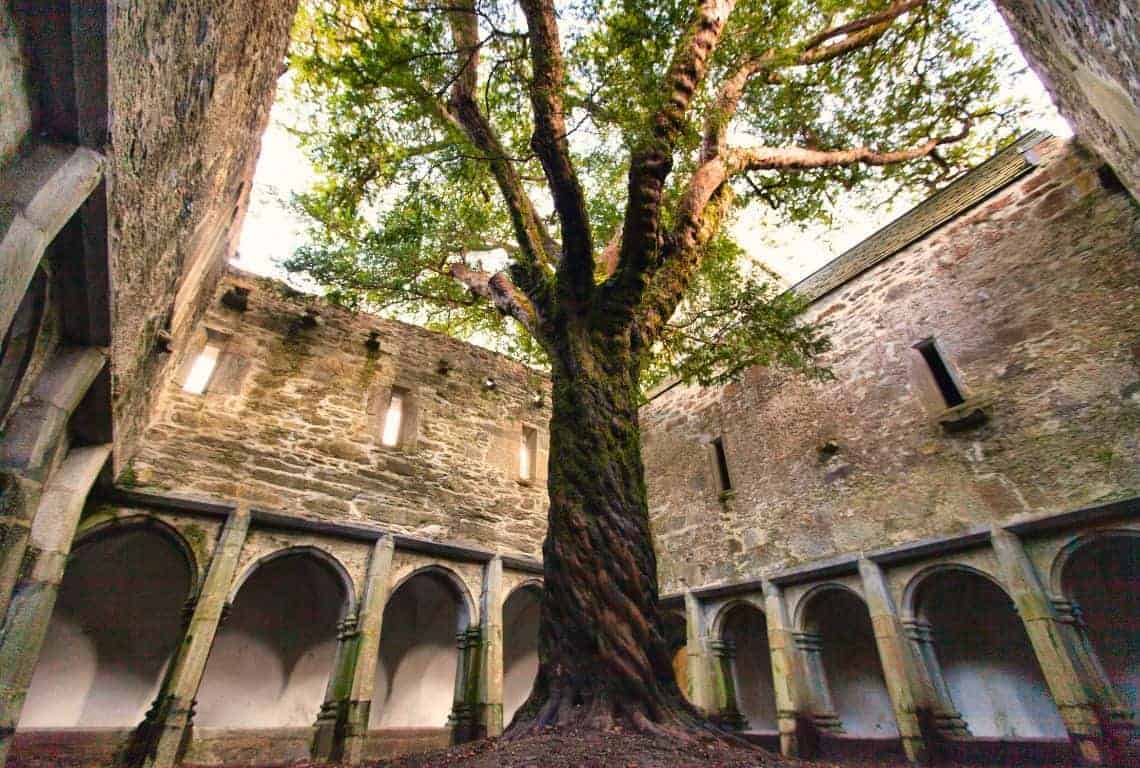
Muckross Abbey in Killarney National Park
Torc Waterfall
Torc Waterfall is another popular attraction in Killarney National Park. It plunges approximately 20 meters (66 feet) over rocks into a pool below, surrounded by lush greenery.
INTREPID’S TIP: You have two options to reach Torc Waterfall: either hike the Torc Waterfall Loop Trail or park nearby and take a short walk to reach it. There are 2 parking lots. One is located no more than 5 minutes from the waterfall, and the second one is about 25-20 minutes away from the waterfall.
GOOD TO KNOW: Torc Waterfall’s name comes from ‘torc,’ Gaelic for wild boar. Legend says a cursed man, turning into a boar by night, lived in a cliff cavern. Discovered by a farmer, he offered riches to keep quiet but vanished in anger, creating the waterfall as he disappeared into a nearby lake.
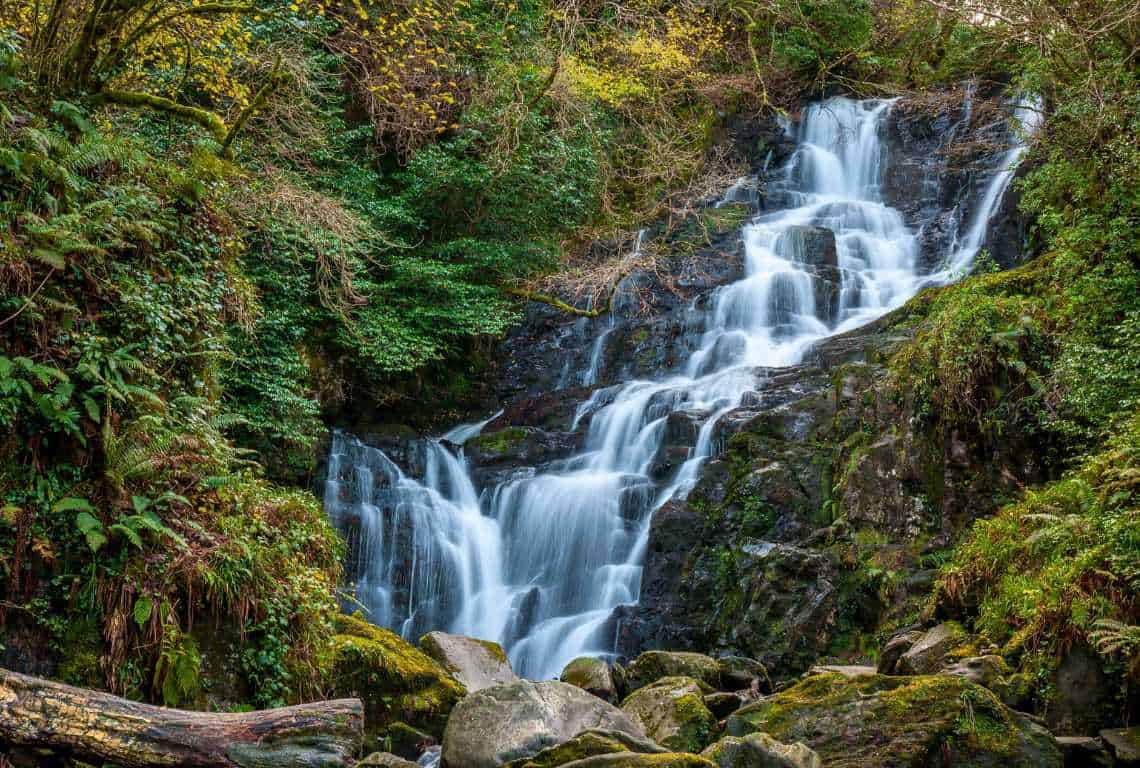
Torc Waterfall in Killarney National Park
Ladies View
The next stop on the itinerary is Ladies View. It offers panoramic vistas of the landscapes surrounding Killarney National Park.
The name “Ladies View” is said to originate from the admiration of the stunning scenery by Queen Victoria’s ladies-in-waiting during her visit to the area in 1861.
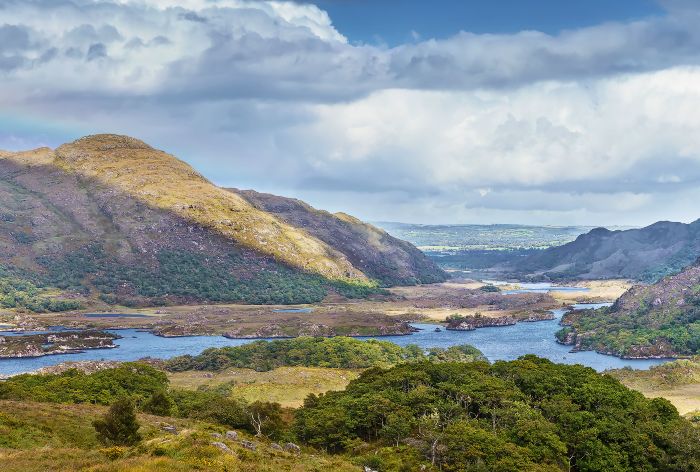
Ladies View
Kenmare Stone Circle
The Kenmare Stone Circle is an ancient archaeological site located near the town of Kenmare. Dating back to the Bronze Age, it is one of the largest stone circles in southwest Ireland.
The circle consists of 15 standing stones, with a diameter of approximately 17 meters (56 feet). Each stone varies in height, with some reaching over 2 meters (6.5 feet) tall.
The purpose of stone circles like this one remains a subject of speculation, but they are often associated with ceremonial or ritualistic practices.
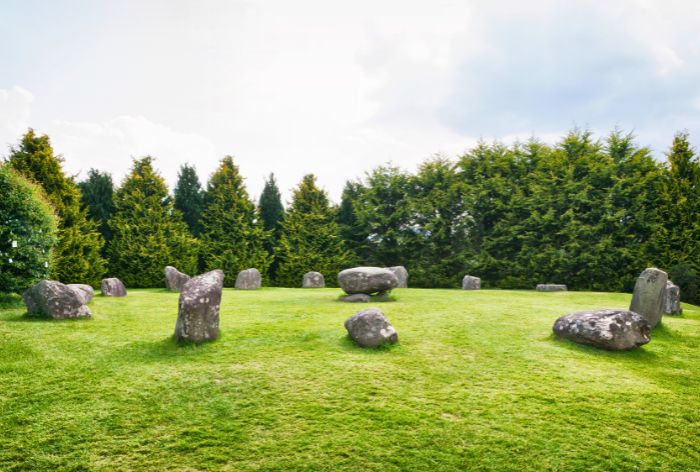
Kenmare Stone Circle
The Kerry Cliffs
Next on your itinerary are the famous Kerry Cliffs.
These dramatic cliffs soar to heights of over 300 meters (984 feet) above the Atlantic Ocean, offering breathtaking views of the rocky shoreline below.
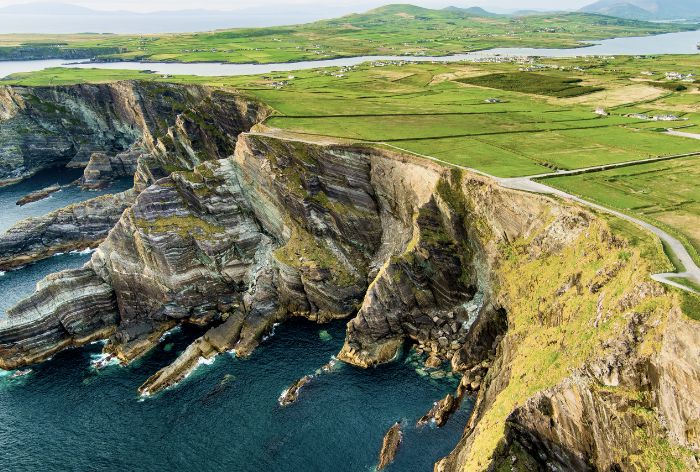
The Famous Kerry Cliffs on Ireland Road Trip Itinerary
You can take in the awe-inspiring vistas from designated viewing points along the cliff edge.
The Kerry Cliffs are definitely a must-visit stop on any tour of the Ring of Kerry!
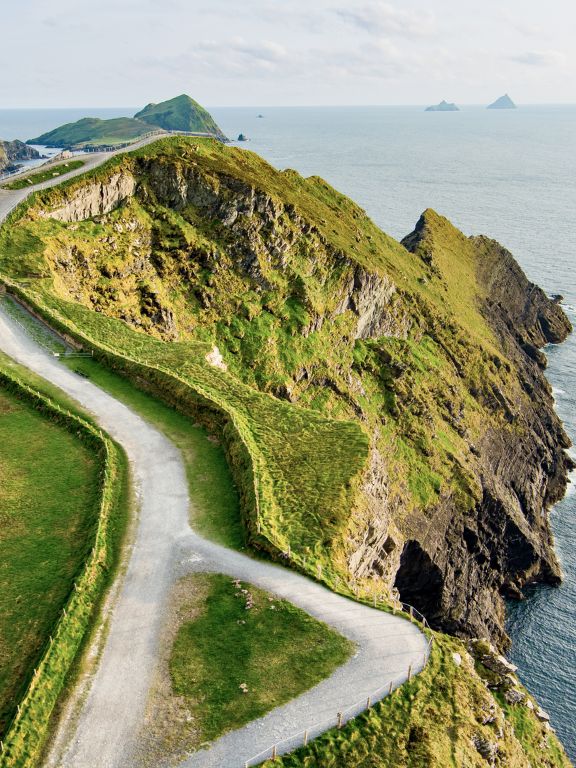
Aerial View of Kerry Cliffs on Ireland Road Trip Itinerary
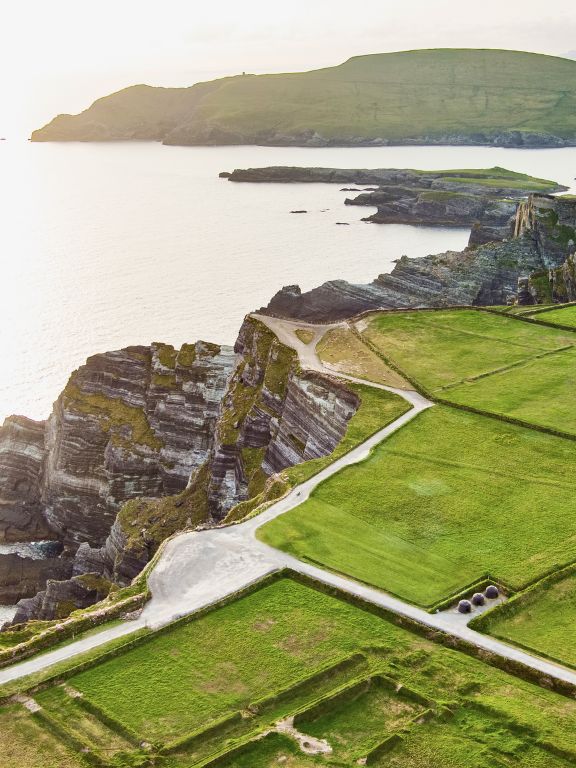
Aerial View of Kerry Cliffs on Ireland Road Trip Itinerary
Valentia Island
Next on the itinerary is Valentia Island, one of my favorite stops on the Ring of Kerry.
Valentia Island is accessible via a bridge from the mainland near Portmagee or by ferry from Cahersiveen.
One of Valentia’s notable landmarks is Geokaun Mountain and Fogher Cliffs, offering panoramic views of the surrounding area, including the Skellig Islands.
Valentia is also known for its rich history, including ancient stone forts, monastic sites, and the Valentia Island Tetrapod Trackway, one of the oldest known footprints of a vertebrate animal.
Additionally, the island is home to the Valentia Island Lighthouse, which has guided ships along the Wild Atlantic Way for over 200 years.
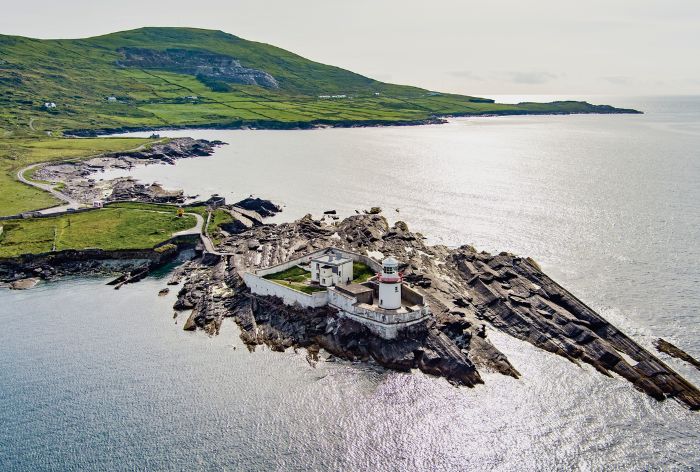
Valentia Island
DAY 5 - Dingle Peninsula
- Minard Castle
- Beehive Huts
- Slea Head Viewpoint
- Blasket’s View
- Dunquin Pier
- Gallarus Oratory
- Conor Pass
- Drive to Tralee and Settle Into Your Accommodations
GOOD TO KNOW: Day 5 of your itinerary takes you on a scenic journey along the Dingle Peninsula. Begin your day with a visit to Minard Castle. Continue to explore with a stop at the Beehive Huts. Pause at Slea Head Viewpoint and Blasket’s View. Make a detour to Dunquin Pier. Finally, traverse the stunning Conor Pass.
Minard Castle
The first stop on your Dingle Peninsula adventure is the historic Minard Castle. Perched on a hill overlooking Kilmurry Bay, this ancient fortress, constructed by the Fitzgerald clan, stands as a testament to the region’s rich history.
Although now in ruins, Minard Castle was once a formidable stronghold, boasting four stories with vaulted ceilings on its lower levels. Sadly, the castle met its demise during a siege by Oliver Cromwell’s troops in 1650, leaving no survivors.
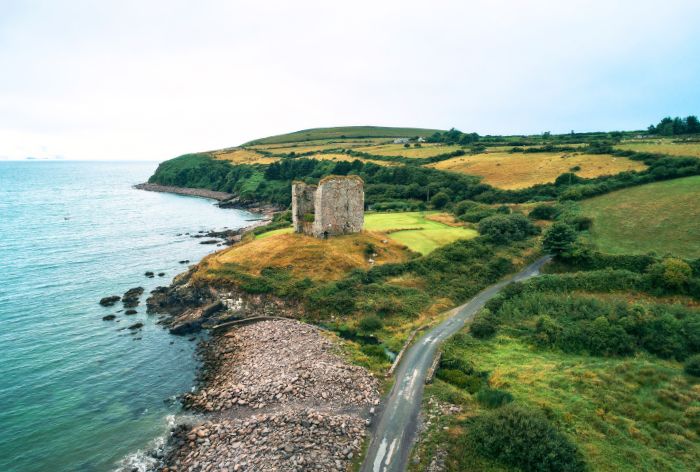
Aerial View of Minard Castle on Dingle Peninsula
Beehive Huts
The next stop on the Dingle Peninsula is beehive huts also known as clocháin. Here you can discover a unique piece of Ireland’s ancient past.
These conical stone structures are crafted using the ancient drystone corbelling method, a technique where rings of stone are meticulously stacked on top of each other, forming a snug, pointed roof.
Dating back over 1,400 years to the Neolithic period, these huts are characteristic of the area’s rich Celtic tradition and are commonly associated with religious sites.
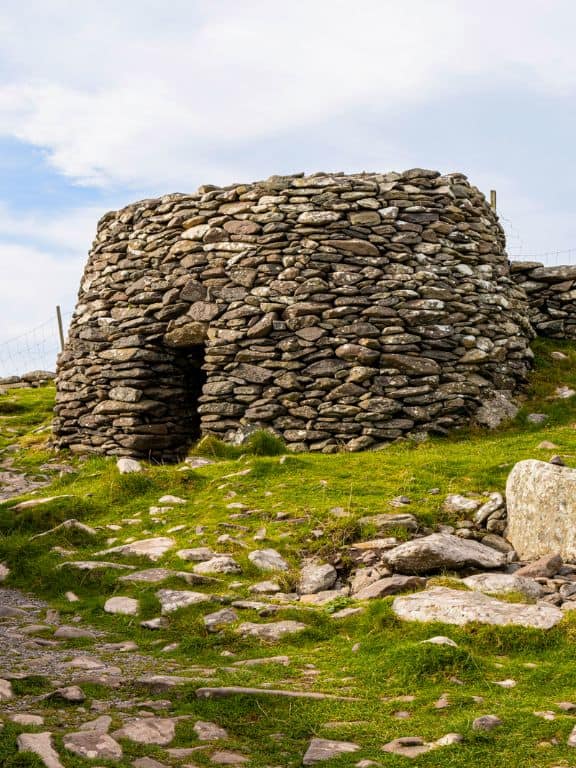
Beehive Huts on the Dingle Peninsula
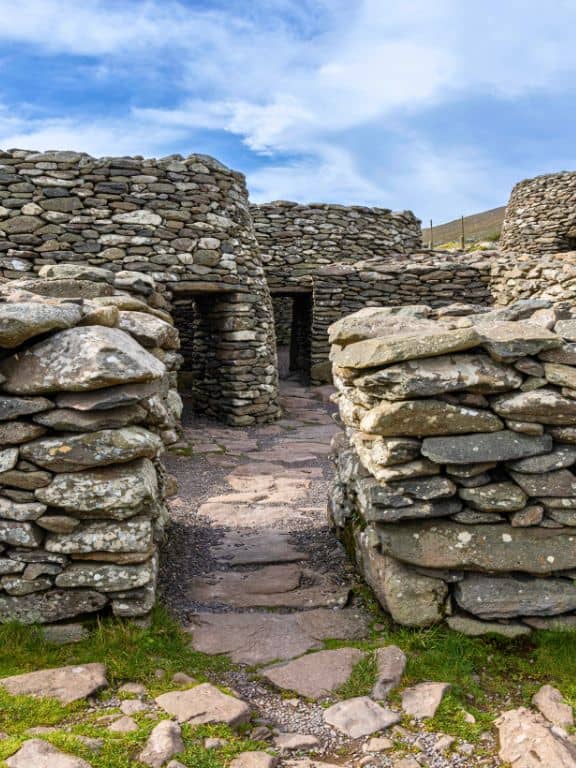
Best Stops on the Dingle Peninsula Drive
Ceann Sléibhe (Slea Head) Viewpoint
The next stop is Ceann Sléibhe (Slea Head), a promontory on the Dingle Peninsula.
It is located in the westernmost part of the Dingle Peninsula and connects the rugged landscape to the small villages of Ballyickeen and Coumeenoole.
The viewpoint offers stunning views of ancient forts, beaches, historic churches, and the Blasket Islands.
Ceann Sléibhe is renowned for its role as a filming location in movies such as “Ryan’s Daughter” and “Far and Away.” Additionally, it is part of the Wild Atlantic Way, a scenic coastal route spanning the entire west coast of Ireland.
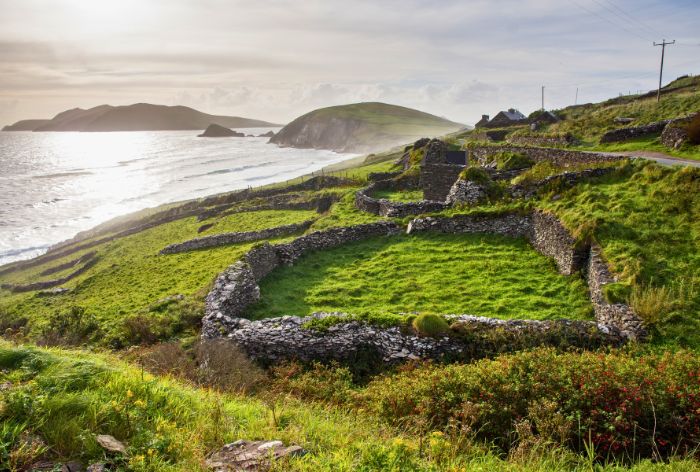
Ceann Sléibhe (Slea Head) Viewpoint
Radharc na mBlascaoidí / Blasket's View
The next stop on the journey is Radharc na mBlascaoidí, also known as Blasket’s View.
This scenic viewpoint offers breathtaking vistas of the Blasket Islands, a group of rugged and uninhabited islands off the coast.
The viewpoint offers a stunning perspective of the island’s dramatic cliffs, rolling hills, and the vast expanse of the Atlantic Ocean beyond. Blasket’s View is in my opinion a highlight on the drive where you can soak in the natural beauty of this remote and wild coastline.
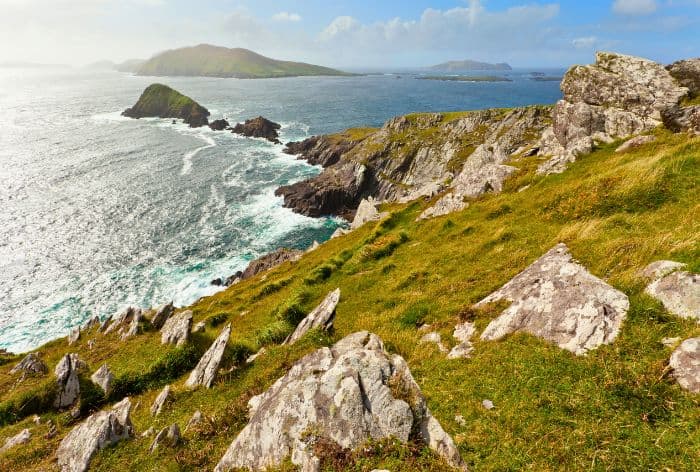
Blasket’s View on the Dingle Peninsula
Dunquin Pier
The next stop is another highlight of the drive, Dunquin Pier, also known as Dun Chaoin Pier.
Dunquin Pier is a historic landmark situated at the edge of the Atlantic Ocean offering stunning views of the coastline and the nearby Blasket Islands.
Dunquin Pier has served as an important transportation hub for centuries, providing access to the islands and serving as a lifeline for the local community.
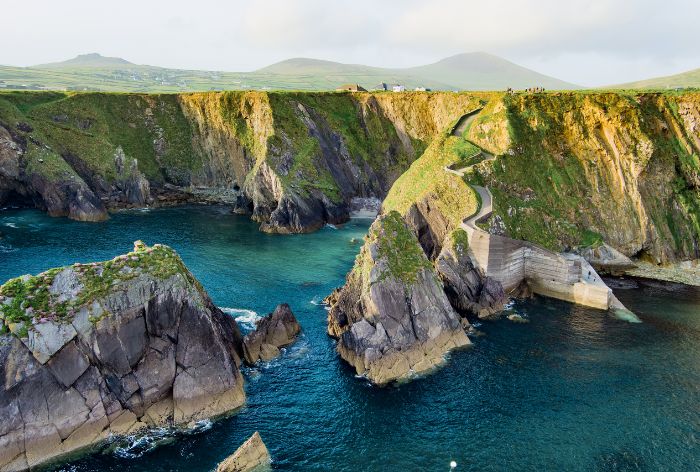
Aerial View of the Dunquin Pier
Gallarus Oratory
The next highlight on the Dingle Peninsula Drive is Gallarus Oratory. It is one of the finest examples of early Christian architecture in the country.
This ancient stone structure, dating back to the 7th or 8th century, is renowned for its remarkably well-preserved corbelled roof and dry-stone construction. The oratory is shaped like an upturned boat, with a small entrance on its western side.
Gallarus Oratory stands as a testament to the skill and craftsmanship of its builders, who constructed it without the use of mortar.
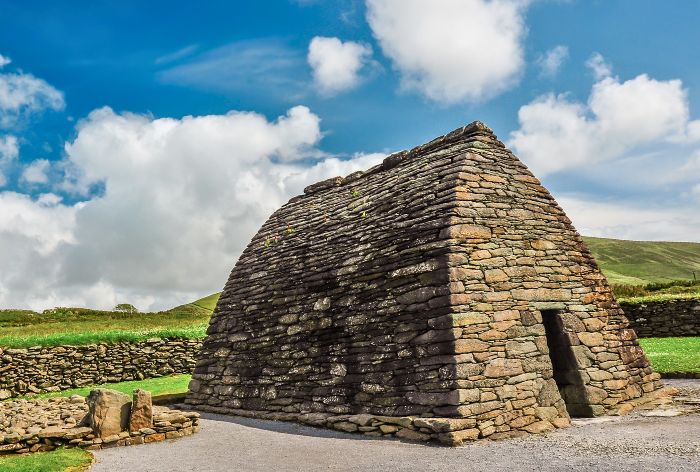
Gallarus Oratory
Conor Pass
Head of you is the drive to the town of Dingle and then your journey will continue to the famous Conor Pass.
Conor Pass stands as Ireland’s highest mountain pass, reaching an impressive height of 456 meters above sea level.
The narrow and twisting road spans approximately 12 kilometers between Dingle Town and Kilmore Cross, boasting an average gradient of 5.6% and bridging a vertical ascent of 399 meters.
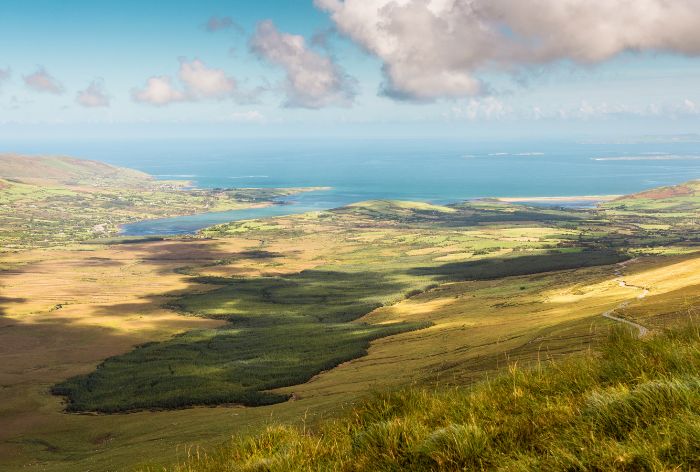
Conor Pass
Drive to Tralee and Settle into Your Accommodations
Head of you is the drive to Tralee.
In Tralee, my two recommended places to stay are:
Ballygarry House Hotel & Spa: This elegant hotel offers luxurious accommodations in a tranquil setting just outside Tralee. With stylish rooms, excellent dining options, and a relaxing spa, Ballygarry House Hotel provides a perfect blend of comfort and sophistication.
The Ashe Hotel: Located in the heart of Tralee, The Ashe Hotel offers modern and stylish rooms, along with top-notch amenities and attentive service.
DAY 6 - Tralee to the Cliffs of Moher
- Adare Manor
- Limerick
- Doolin
GOOD TO KNOW: Today’s trip from Tralee to Doolin includes two standout stops: Adare Manor and Limerick. Admire the stunning architecture of Adare Manor before exploring the cultural heritage of Limerick, home to attractions like King John’s Castle and the Hunt Museum. Then, head to Doolin, settle into your accommodations, and get plenty of rest for the next day’s hike along the Cliffs of Moher.
Adare Manor
The first stop on today’s itinerary is Adare Manor, a 19th-century Neo-Gothic manor house that sits on an 840-acre estate in County Limerick.
Adare Manor was built in 1832 and it has some impressive features such as 365 leaded windows, 52 chimneys, and four towers representing days, weeks, seasons, and days of the week.
The Great Hall, designed by Augustus Welby Northmore Pugin, is a standout architectural marvel and you should not miss it.
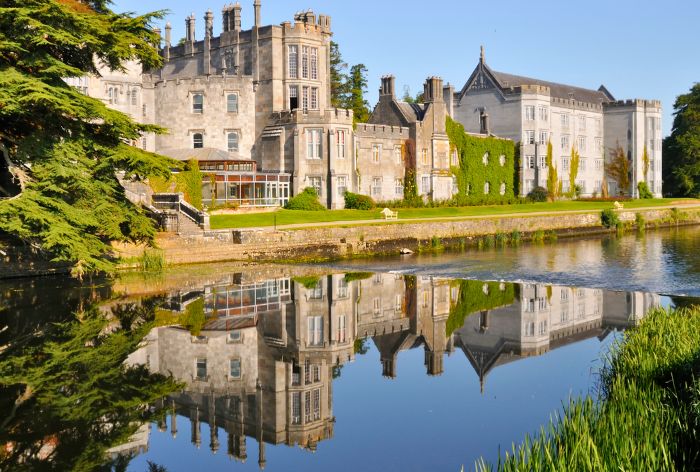
Adare Manor
Adare Manor also houses a Michelin-starred restaurant and the afternoon tea gallery, however, reservations are highly recommended if you are interested.
My recommendation is to check out a self-guided tour of the Manor House and Manor Museum. The tour offers insights into the estate’s architecture and gardens.
Limerick
The next stop on the journey is Limerick.
The 3 standouts in Limeric for me are King John’s Castle, a 13th-century fortress, the Hunt Museum that houses a diverse collection of artifacts, artworks, and antiquities spanning over 2,000 years of history, and the scenic River Shannon, Ireland’s longest river, that flows through the heart of Limerick. Here are some highlights you should know about each place:
- King John’s Castle was built between 1200 and 1210 at the behest of King John of England. The castle’s construction was intended to assert Norman dominance over the Gaelic Chieftains of the West during the first Norman conquest of Ireland.
Interestingly, despite its name, King John never set foot in the castle, having passed away before its completion in 1216. It wasn’t until centuries later that the fortress came to be known as “King John’s Castle”.
The castle itself is a formidable structure, boasting an array of impressive features including a massive gatehouse, battlements, corner towers, curtain walls, and drum towers.
Make sure to take a tour of the castle and ascend the towers for sweeping vistas of the city and river below.
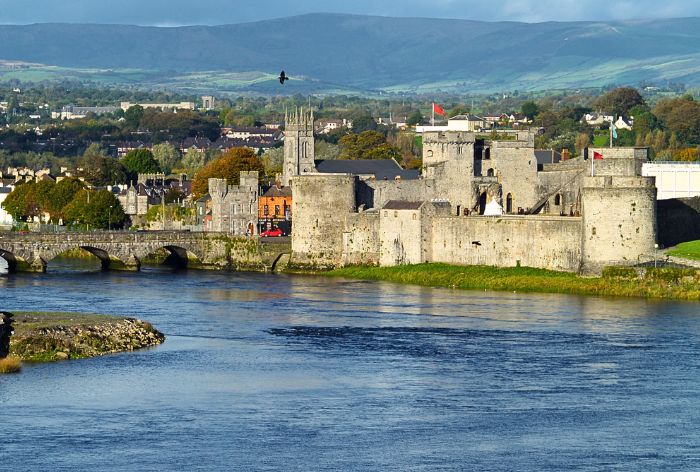
King John’s Castle in Limerick
- Next head over to the Hunt Museum. The Hunt Museum is a cultural gem. It houses a diverse collection of artifacts and artworks spanning over 2,000 years of history.
Founded by John and Gertrude Hunt in 1978, the museum is housed within the historic 18th-century Custom House overlooking the River Shannon.
The museum’s collection includes items ranging from ancient Egyptian artifacts and medieval religious objects to fine art pieces by renowned artists such as Picasso, Renoir, and Yeats.
One of the museum’s highlights is the collection of medieval and Renaissance objects, including intricately carved ivory pieces and illuminated manuscripts.
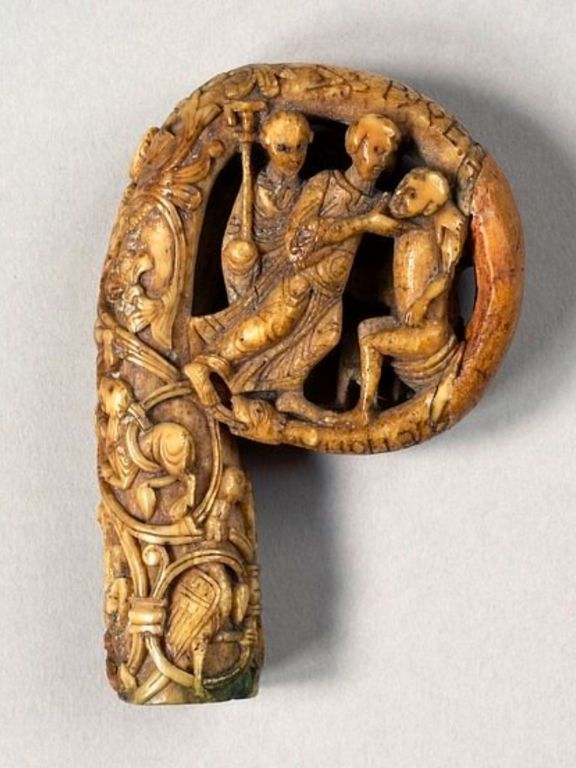
The Hunt Museum in Limerick

The Hunt Museum in Limerick
- Finish off your visit to Limerick with a stroll along the River Shanon. There are lots of cafes and restaurants, so make sure to grab something to eat before heading out to Doolin.
Settle Into Your Accommodations in Doolin
After visiting Limerick head over to Doolin and settle into your accommodations. You will stay for 2 nights in Doolin.
My recommendation is to check out West Haven House. It offers very clean and comfortable accommodations with scenic countryside views.
Another option is Hotel Doolin, situated in the heart of the village, which features comfortable modern rooms. Its onsite restaurant serves farm-to-table cuisine.
DAY 7 - Cliffs of Moher
- Cliffs of Moher Walking Trail
GOOD TO KNOW: Today, you will embark on a hike along the famous Cliffs of Moher.
Cliffs of Moher Walking Trail
The Cliffs of Moher Walking Trail will offer you the opportunity to experience the stunning coastal scenery on foot, with the option to start at either the Doolin trailhead or Hag’s Head.
My recommendation is to begin at Hag’s Head.
Park at the Cliffs of Moher Visitors Center, then take a free shuttle from the Visitor’s Center to the Hag’s Head parking area near the Hag’s Head Viewpoint.
The distance from Hag’s Head. Viewpoint to the Cliffs of Moher Visitor Centre is approximately 8 kilometers (about 5 miles) along the Cliffs of Moher Coastal Walk.
The trail follows the rugged coastline, providing breathtaking views of the cliffs and the Atlantic Ocean along the way. While the walk can be challenging due to uneven terrain and steep sections, it offers an unforgettable adventure amidst some of Ireland’s most spectacular landscapes.
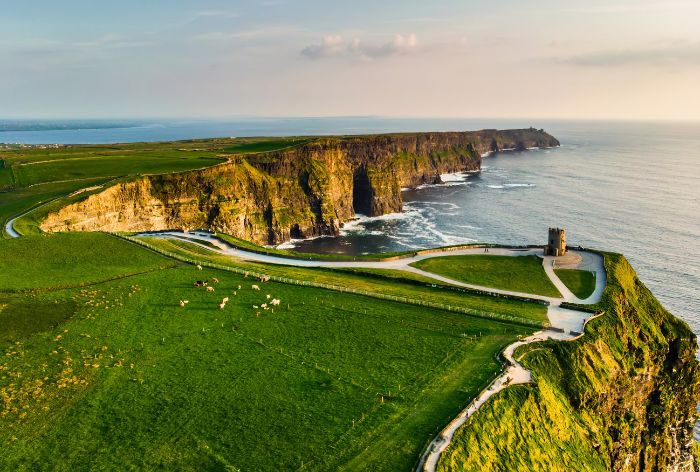
Aerial View of the Cliffs of Moher
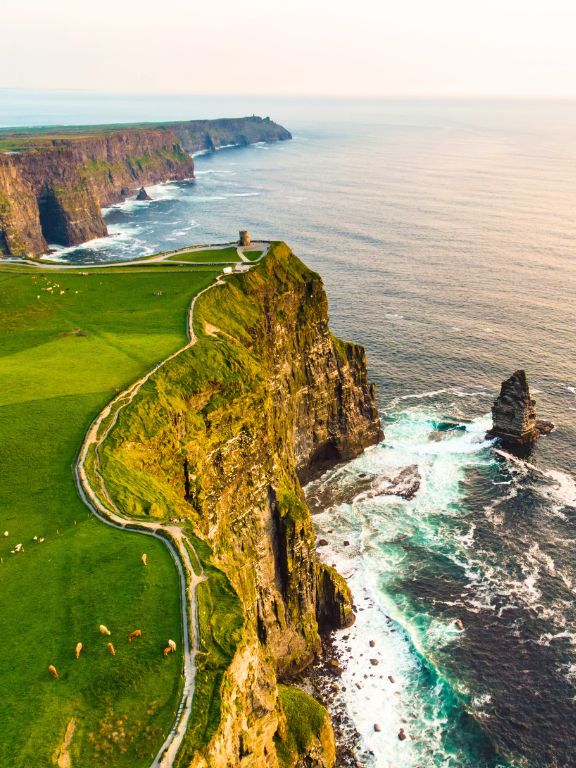
Aerial View of the Cliffs of Moher
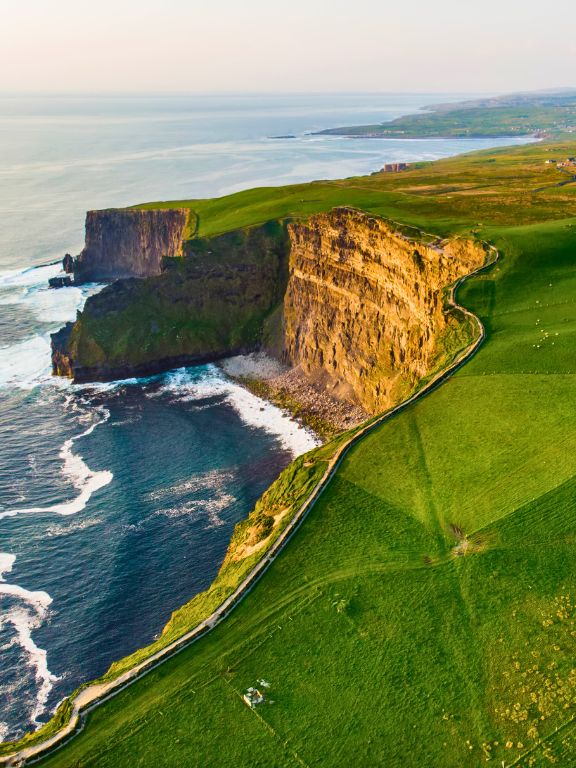
Aerial View of the Cliffs of Moher
DAY 8 - Doolin to Portrush
- The Burren
- Ashford Castle
- Slieve League
- Settle Into Your Accommodations in Portrush
GOOD TO KNOW: Day 8 starts with exploring the unique landscape of The Burren. Next, you will visit the majestic Ashford Castle. Then, journey to Slieve League, home to some of Europe’s highest sea cliffs. Finally, settle into your accommodations in Portrush, a charming seaside town.
The Burren
The first stop on Day 8 of your journey is the Burren, a unique limestone landscape.
Stretching over 250 square kilometers, the Burren is renowned for its otherworldly terrain, characterized by vast expanses of exposed limestone pavement, rocky outcrops, and karst formations.
Despite its seemingly barren appearance, the Burren is home to many flora and fauna, including rare alpine and Mediterranean plants that thrive in its limestone crevices.
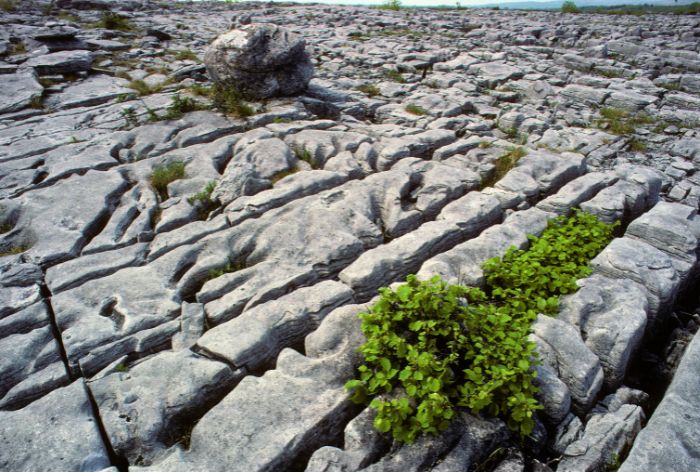
The Burren
One of the things you should not miss is the iconic Poulnabrone Dolmen, an ancient megalithic tomb dating back over 5,000 years.
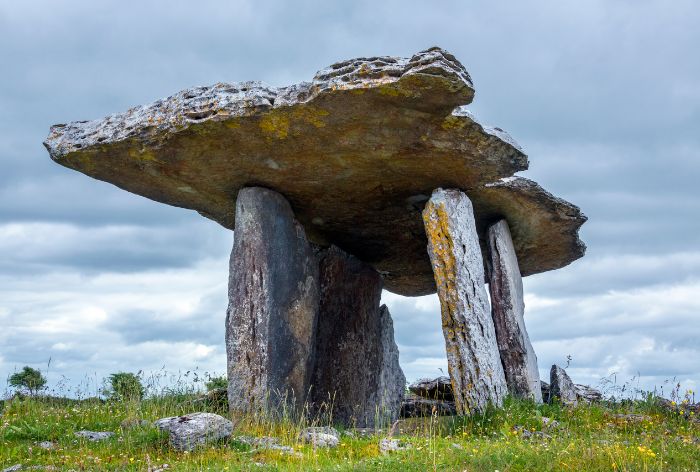
Iconic Poulnabrone Dolmen
Ashford Castle
Next is Ashford Castle, turned into a luxurious five-star hotel. Originally built as a medieval castle in the 13th century, Ashford Castle has been transformed into a grand Victorian estate.
The castle grounds are open to the public for walking, with a nominal fee of 5 Euro per person. Upon arrival, request a map from the doorman for a self-guided tour around the estate. You will be able to discover many of the filming locations for the popular TV series “Reign.”
My recommendation is that you pre-book lunch to secure a table and also give you an opportunity for an extra glimpse of the castle’s interior, which is open to patrons only.
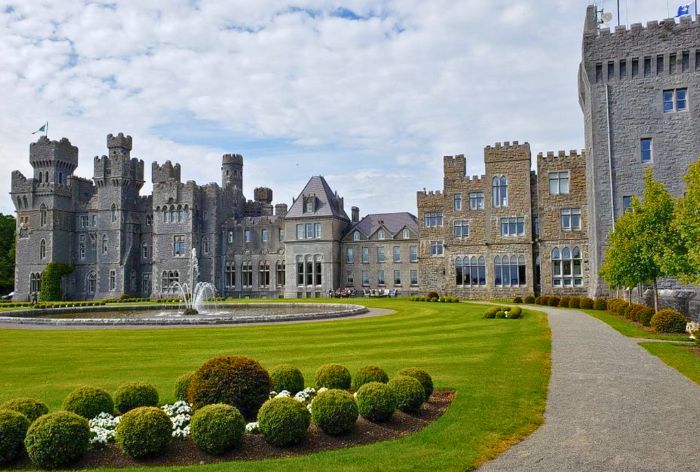
Ashford Castle
Slieve League
If you thought that the Cliffs of Moher were spectacular, just wait and see Slieve League!
Slieve League is home to some of the highest sea cliffs in Europe, towering dramatically over the Atlantic Ocean. These majestic cliffs reach heights of over 600 meters (1,968 feet).
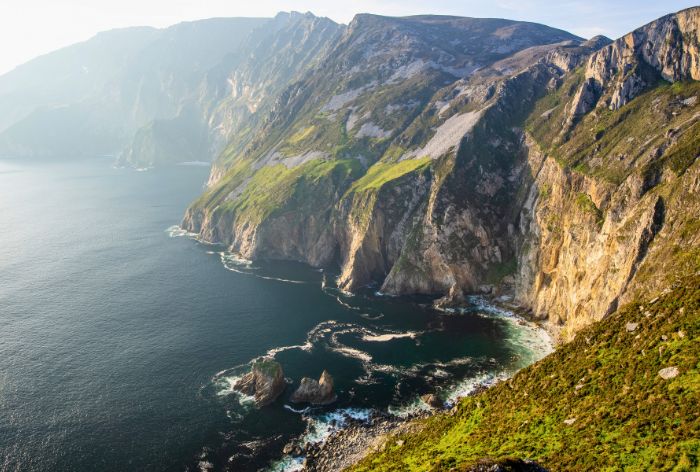
Slieve League
GOOD TO KNOW: The most popular viewing point is known as One Man’s Path, a narrow trail that winds its way along the cliff edge, providing exceptional views.
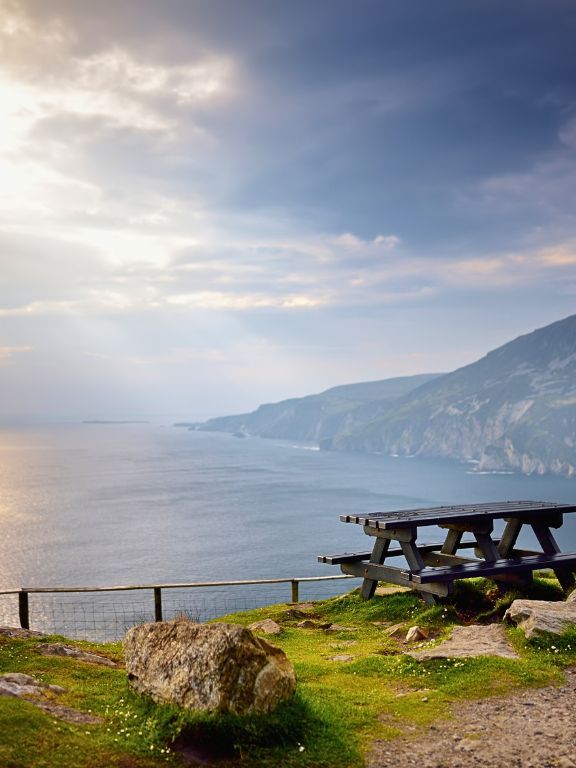
Slieve League
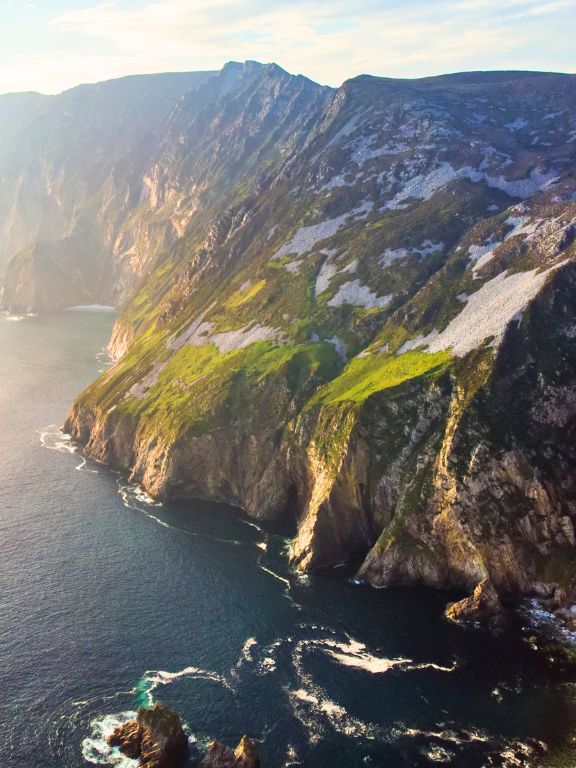
Slieve League
Settle Into Your Accommodations in Portrush
Tonight you will be staying in Portrush.
For a comfortable stay consider the Inn on the Coast in Portrush. It is a retreat after a day of exploring the stunning attractions of the Causeway Coast.
Alternatively, the Portrush Atlantic Hotel is a good option as well. It provides modern accommodations and excellent amenities.
DAY 9 - Northern Ireland
- Dunluce Castle
- Giants Causeway
- Carrick-A-Rede Rope Bridge
- The Dark Hedges
- Drive to Belfast and Settle Into Your Accommodations
GOOD TO KNOW: On day 9, you will say goodbye to the charming Portrush, and embark on a journey through Northern Ireland’s iconic landmarks. You will start with the awe-inspiring Dunluce Castle, perched dramatically on a cliff’s edge. From there, you will venture to the geological wonder of the Giant’s Causeway with hexagonal basalt columns. Next, you will test your nerves at the Carrick-a-Rede Rope Bridge, suspended over breathtaking coastal views. As the day progresses, you will visit the Dark Hedges, where ancient beech trees form a mystical canopy. Finally, you will arrive in Belfast, where you can unwind and rest.
Dunluce Castle
Dunluce Castle, perched dramatically on a cliff overlooking the North Atlantic, is a must-stop on your Ireland road trip.
The castle is accessible by a bridge, which makes a thrilling entrance to its historic grounds.
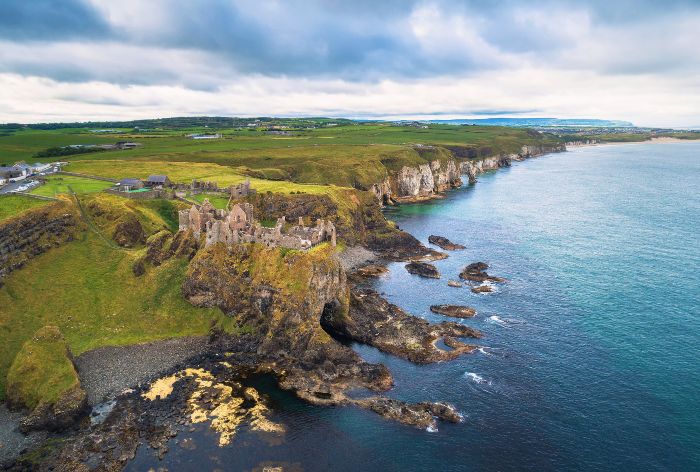
Aerial View of Dunluce Castle / 10-Day Ireland Road Trip Itinerary
Originally built in the 13th century by Richard Óg de Burgh, the 2nd Earl of Ulster. The castle’s present ruins primarily date back to the 16th and 17th centuries, with its history entwined with the McQuillan and MacDonnell clans.
Dunluce Castle gained fame as the seat of House Greyjoy in the hit TV show Game of Thrones. It is a tourist hotspot with many day tours from Belfast and Dublin.
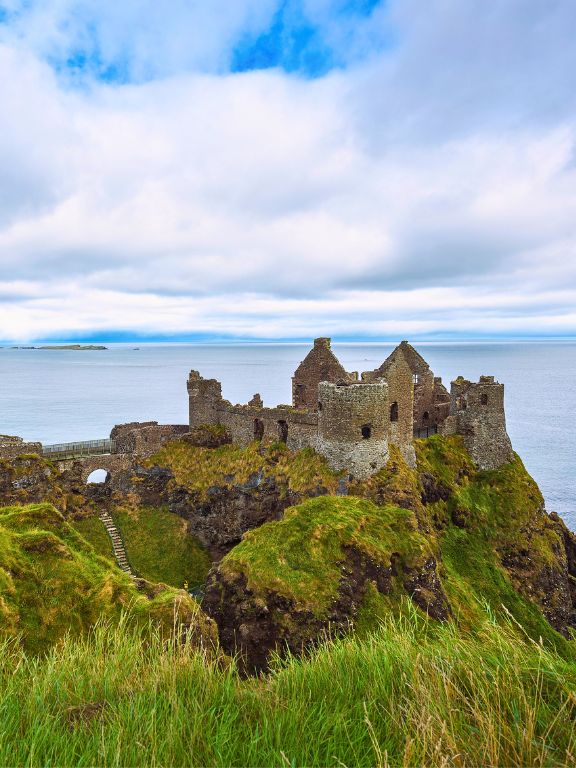
Dunluce Castle
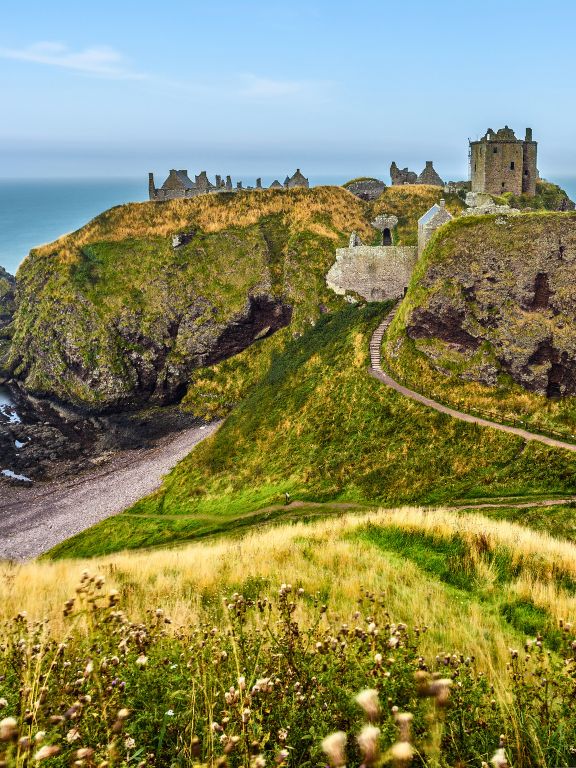
Dunluce Castle
Giants Causeway
The next destination on your itinerary is the legendary Giant’s Causeway, a UNESCO World Heritage Site renowned for its spectacular natural beauty and geological wonders. Here, you’ll encounter over 40,000 interlocking basalt columns, each with a unique hexagonal shape, formed by volcanic activity millions of years ago.
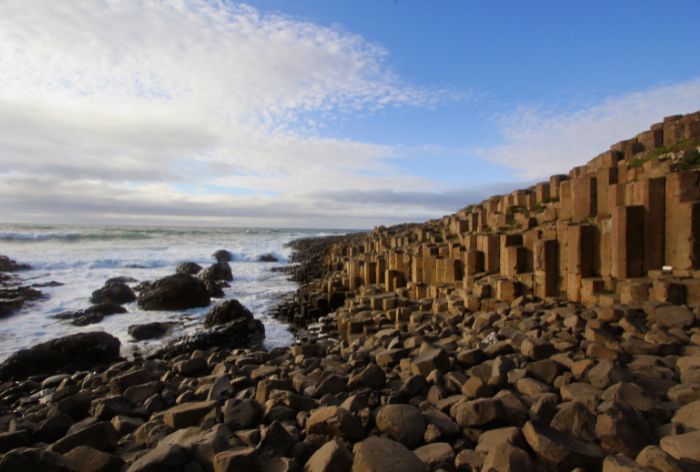
Legendary Giants Causeway
These columns, typically five to seven irregular sides, stand as witnesses to the forces of nature that shaped them over 60 million years ago. From volcanic eruptions to slow cooling and rising sea levels, the Giant’s Causeway is a testament to the incredible power of geological processes.
As you explore, take note of the distinctive “ball and socket” joints, where horizontal fractures create a convex bottom face and a concave upper face.
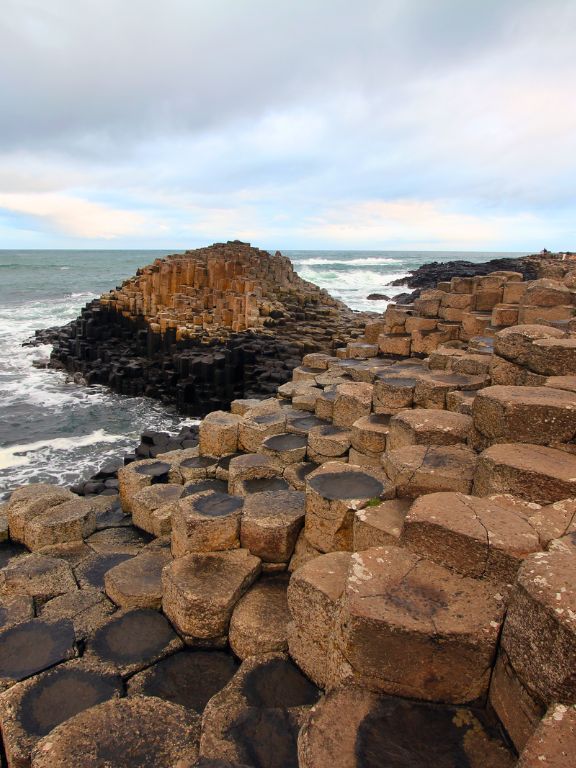
Giants Causeway
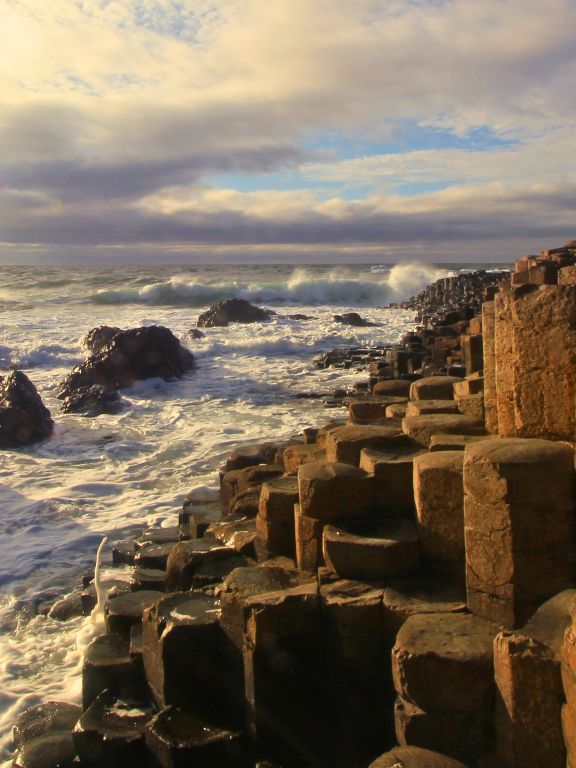
Giants Causeway
Carrick-a-Rede
Next up is Carrick-a-Rede. It’s famed for its 66-foot chasm crossed by a rope bridge, initially built by salmon fishermen over 350 years ago.
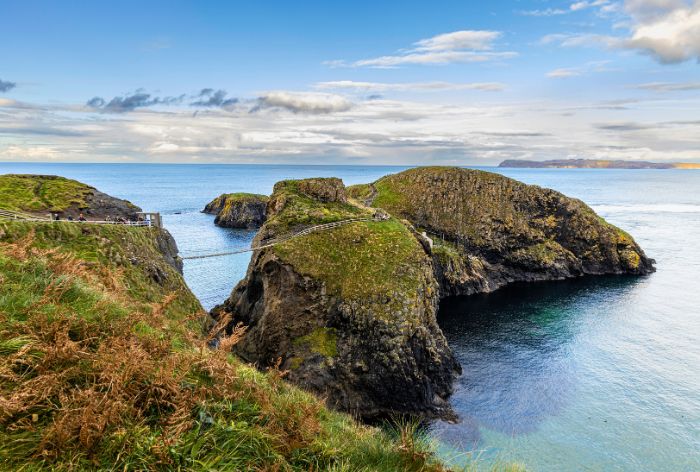
Carrick-a-Rede Rope Bridge
You should definitly brave the bridge for stunning coastal views and an adrenaline rush.
Once you cross, explore the Carrick-a-Rede Island and soak in the natural beauty.
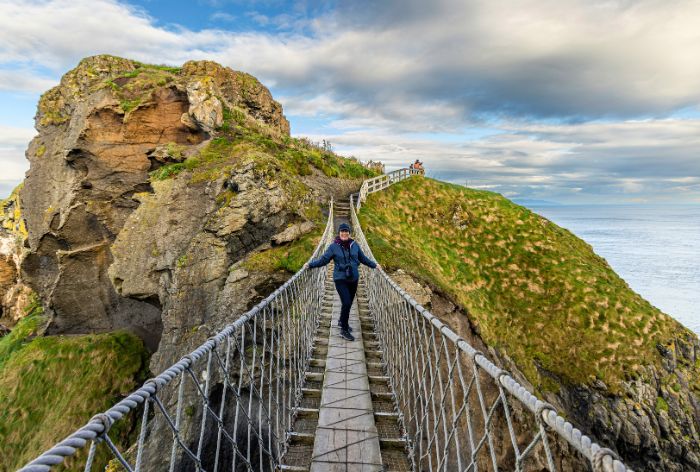
Carrick-a-Rede Rope Bridge
The Dark Hedges
Next on your itinerary are the Dark Hedges, a mesmerizing avenue of beech trees. Planted in the 18th century, these gnarled trees create a hauntingly beautiful tunnel, making it a must-see stop on your Ireland road trip.
To capture the atmosphere of the Dark Hedges, the best time to visit is during sunset when the golden light filters through the branches. Make sure to use a wide-angle lens to capture the full breadth of the avenue.
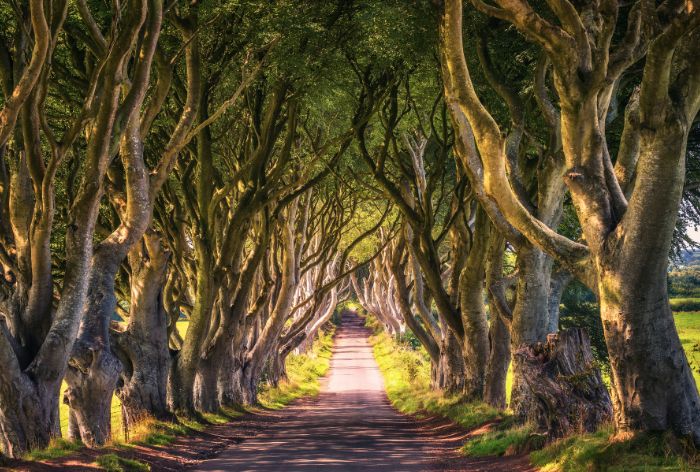
Mesmerizing Dark Hedges
Drive to Belfast and Settle Into Your Accomodations
As you wind down your day of exploration, it’s time to drive to Belfast and settle into your accommodations.
For a cozy and hassle-free stay, I highly recommend the Ibis Belfast City Centre. With its clean, modern rooms and a delicious hot and cold breakfast to kickstart your morning, it’s the perfect home base. Plus, its proximity to downtown shopping and lively pubs means you’re never far from the action.
Alternatively, if you’re seeking a touch of luxury and some elegance, look no further than the Europa Hotel. From its prime location to its impeccable service, every detail is crafted to ensure your comfort. Make sure to indulge in a memorable dining experience at the hotel’s restaurant
DAY 10 - Belfast and Drive Back to Dublin
Belfast
Howth Cliff Walk
Flight Back Home
GOOD TO KNOW: On the final day of your Ireland adventure, you’ll kickstart your morning in Belfast with a brief exploration, choosing from options like the Titanic Belfast museum, Crumlin Road Gaol, or a guided political tour. Afterward, venture to Howth for a picturesque cliff walk along the stunning coastline. Then, it’s time to head to Dublin for your flight back home.
Belfast
Start your day in Belfast with a short exploration before heading to Dublin for your flight home. Here are some options to consider:
- Crumlin Road Gaol: Step back in time with a visit to this historic prison, which operated for over 150 years.
Take a guided tour to learn about its fascinating history, including its role during the Troubles, and explore its eerie underground tunnels.
- Ulster Museum: Discover Northern Ireland’s rich history and culture at the Ulster Museum.
From ancient artifacts to contemporary art, the museum offers a diverse range of exhibits to explore, including the renowned Irish Game of Thrones tapestry. Free entrance.
- Titanic Belfast: Immerse yourself in the story of the Titanic, from its construction in Belfast to its tragic maiden voyage.
Explore interactive exhibits and artifacts in this iconic museum, located on the site of the former Harland & Wolff shipyard. Book your tickets here.
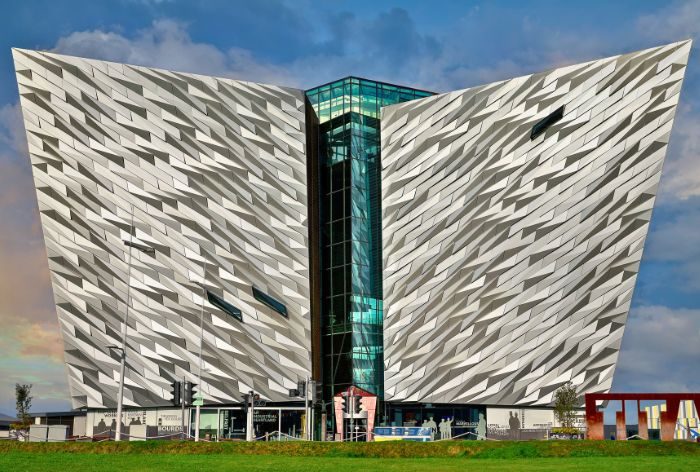
Stunning Titanic Belfast Building
If you prefer a guided experience, consider joining one of these tours:
- Belfast: Political Taxi Tour: Hop into a taxi and embark on a guided tour of Belfast’s political murals and peace walls.
Learn about the city’s complex history and the legacy of the Troubles from a knowledgeable local guide. Book tickets here.
- Belfast: Political Conflict 3-Hour Walking Tour: Lace up your walking shoes and delve into Belfast’s turbulent past on this informative tour.
Visit key sites associated with the city’s political conflict, including murals, memorials, and peace lines. Book your tickets here.
Whichever option you choose, you’ll have a couple of hours to delve into Belfast’s history and culture before continuing your journey to Dublin.
Howth Cliff Walk
Next on your itinerary is the Howth Cliff Walk. This picturesque trail offers stunning views of Dublin Bay and the Irish Sea with the iconic Baily Lighthouse standing as a picturesque landmark along the route.
Despite limited time, you can still enjoy a portion of the well-defined trail. The trail is accessible from the Howth DART station
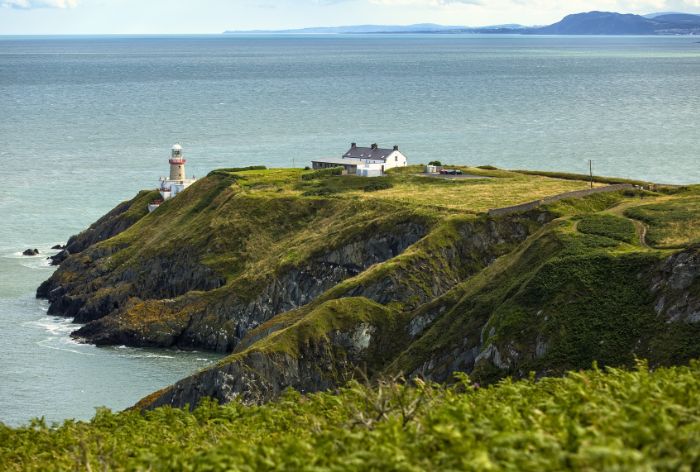
Howth Cliff Walk with Baily Lighthouse in the Distance
Dublin and Flight Back Home
After enjoying the Howth Cliff Walk, it’s time to head back to Dublin and prepare for your flight home.
Reflect on your experiences in Ireland as you return to the city. Grab a meal at a local spot, and maybe pick up some souvenirs. Then, head to the airport, ready to fly home with memories of your trip.
Intrepid Scout's Tips for 10-Day Ireland Road Trip Itinerary
- Drive on the left: Always remember to drive on the left side of the road during your Ireland road trip, and be mindful of roundabouts and traffic flow.
- Rent a compact car: Irish roads are often narrow and winding, so opt for the smallest car that can comfortably accommodate your travel group and luggage. This will make navigating tight spaces and narrow roads much easier.
- Mind pedestrians and cyclists: Pedestrians and cyclists are common along Irish roads, especially in rural areas and scenic routes. Exercise caution and be prepared to yield to them, especially on narrow roads and blind corners.
- Check rental requirements: Ensure you meet all rental car requirements, including age restrictions and documentation like an International Driving Permit if necessary. Review your rental contract carefully to avoid any surprises.
- Drive cautiously: Speed limits in Ireland may not always reflect safe driving speeds, particularly on smaller roads with limited visibility. Take your time, especially on unfamiliar routes, and be prepared for unexpected hazards.
- Self-service gas stations: Gas stations in Ireland typically require payment inside the shop after pumping gas. Familiarize yourself with this process and be prepared to pay before hitting the road.
- Delay car rental in Dublin: If you’re starting your trip in Dublin, consider delaying your car rental until you’re ready to leave the city. Parking in Dublin can be expensive and challenging, so save yourself the hassle and expense by renting a car when you’re ready to explore beyond the city limits.
- Plan for toll roads: Some highways and bridges in Ireland have tolls, so be prepared to pay with cash or card.
More Information About Ireland:
20 Must-See Sights and Attractions in Ireland (Your Essential Guide to the Emerald Isle)
14 Delicious Traditional Irish Foods You Must Try During Your Visit to Ireland
9 Amazing Things to Do in Killarney National Park (Maps+Tips)
22 Best Stops on the Ring of Kerry (Map+Top Attractions at Each Stop)
Perfect 1-Day Ring of Kerry Drive Itinerary
16 Best Stops on the Dingle Peninsula Drive (map+detailed tips)
You Might Also Like:
82 Quotes About Ireland And the Irish Spirit Celebrating the Emerald Isle
102 Beautiful Irish Proverbs and Sayings Offering Timeless Lessons
92 Irish Blessings And Wishes Embracing Joy on St. Patrick’s Day
Did You Find 10-Day Ireland Road Trip Itinerary Useful? Pin It!
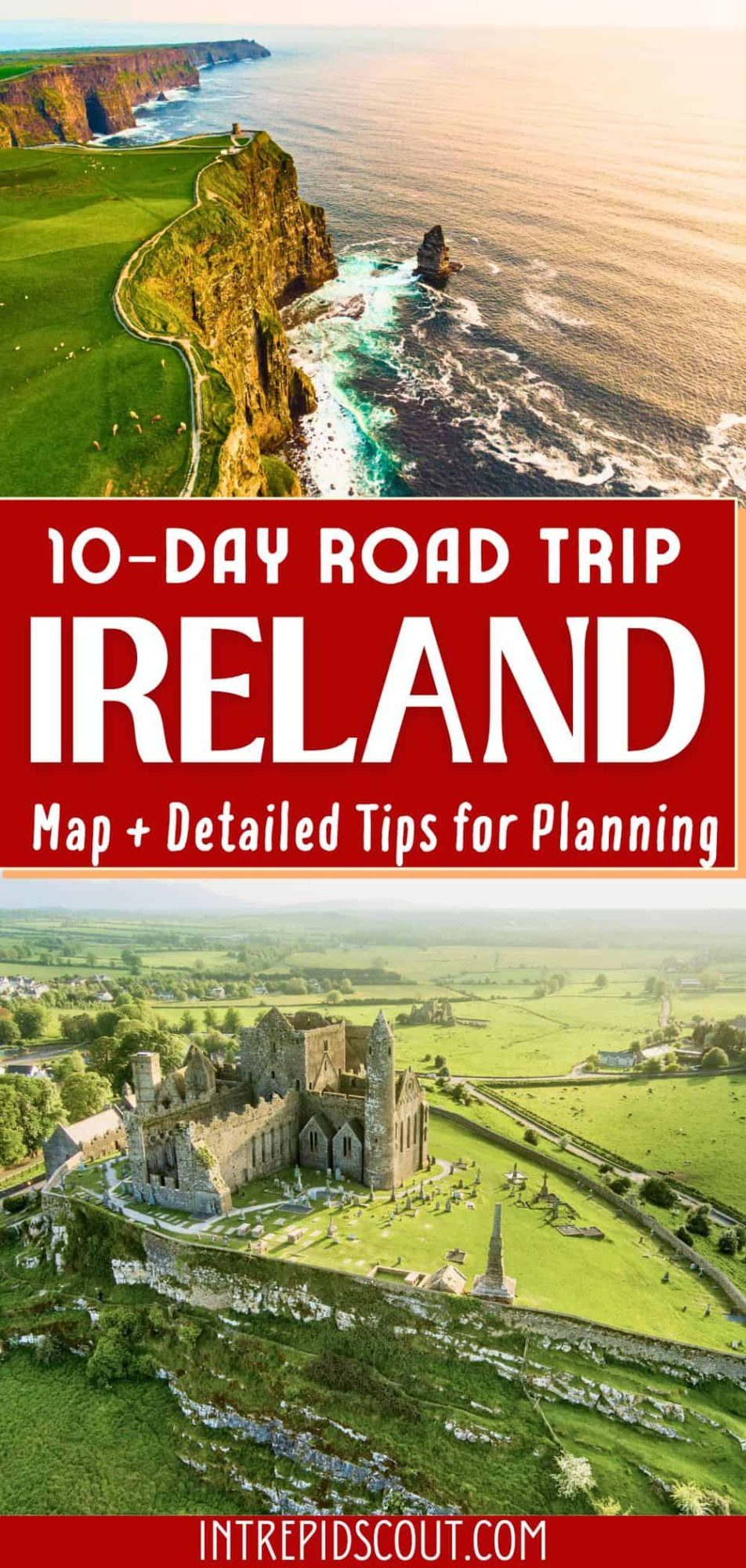
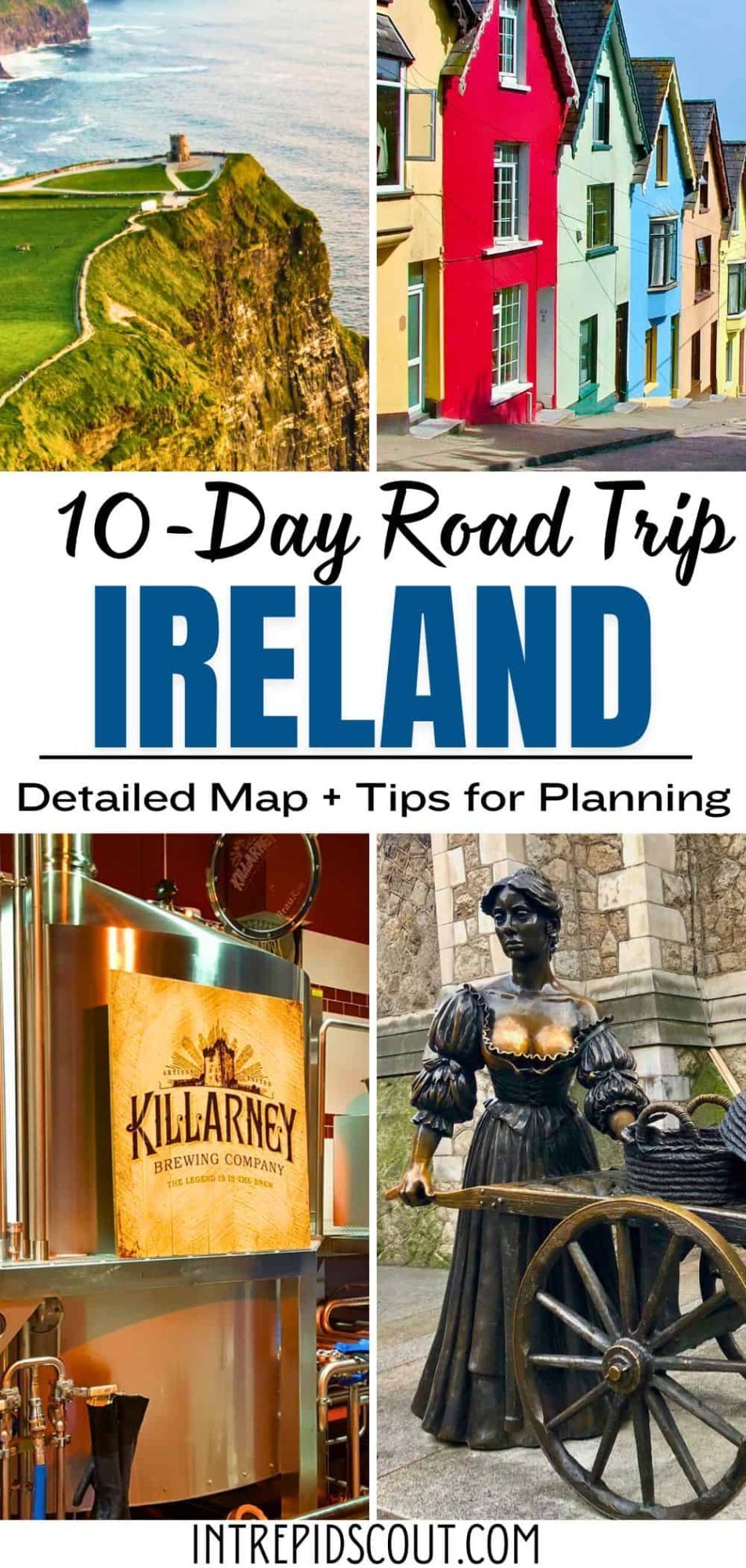
Now, It Is Your Turn, I Would Like to Hear Back from You!
Are you planning your trip to Ireland?
Please let me know! Drop me a quick comment right below!
Click on any of the images below to get inspired and to help you with the planning process for your trip to Ireland!
